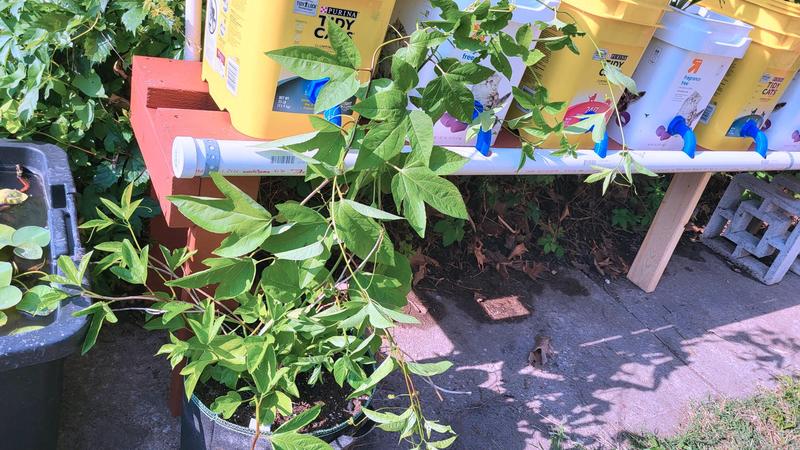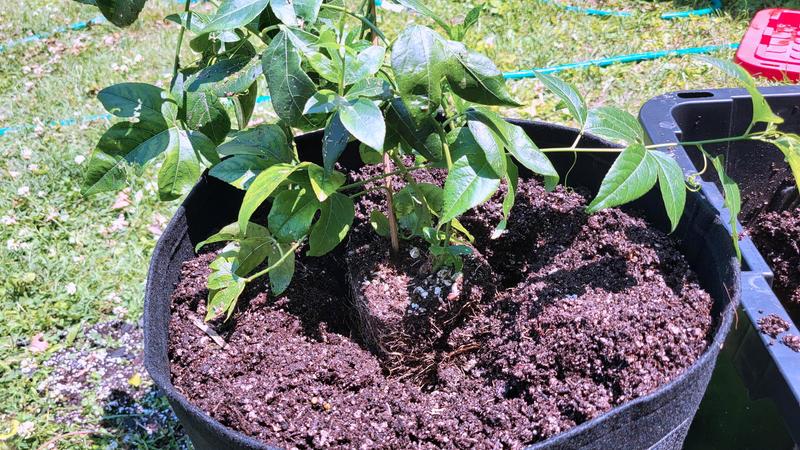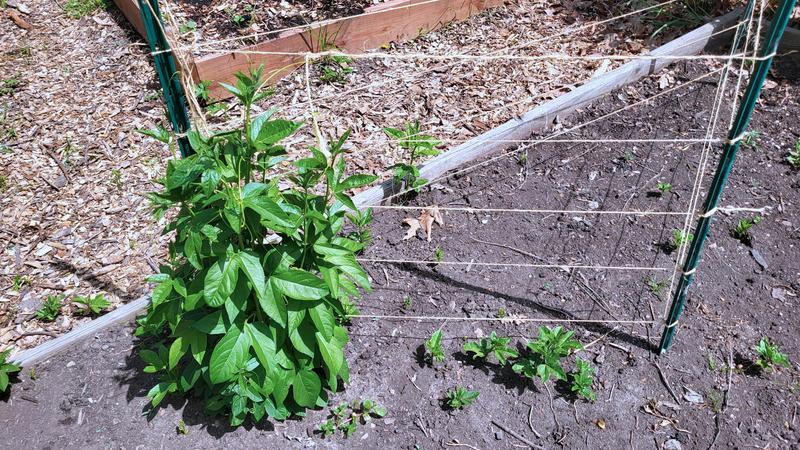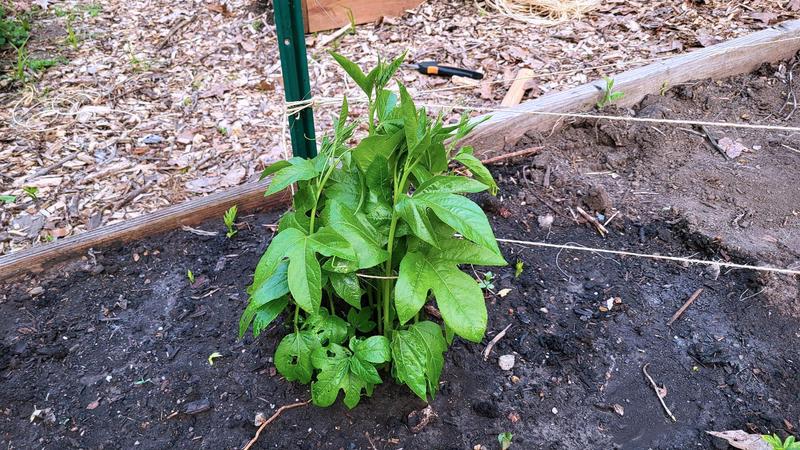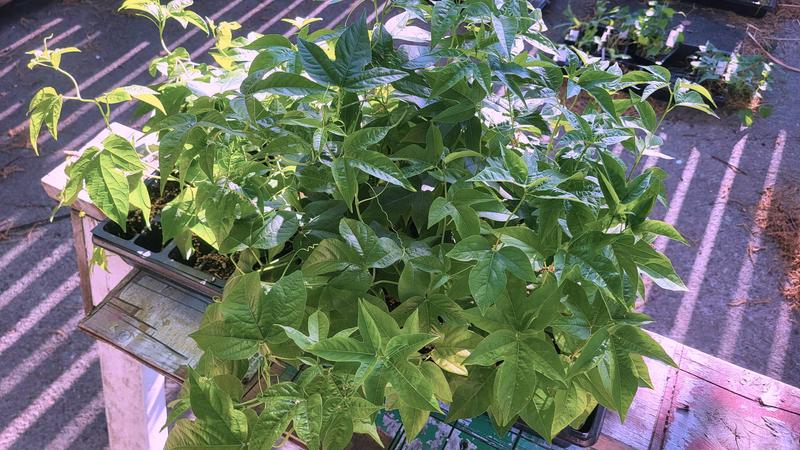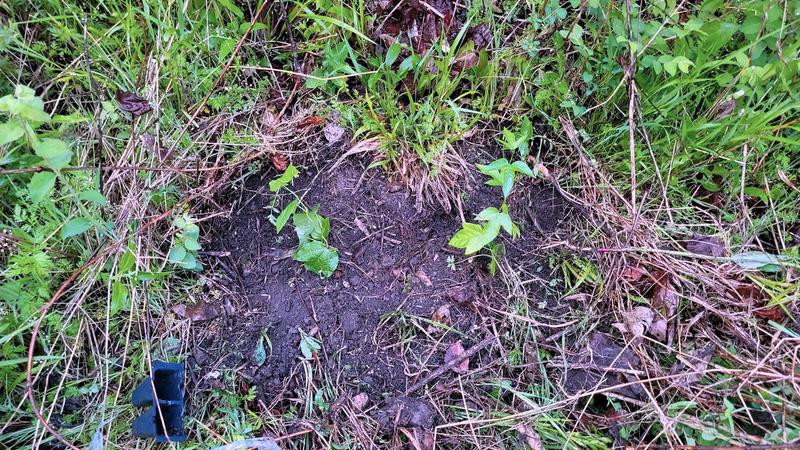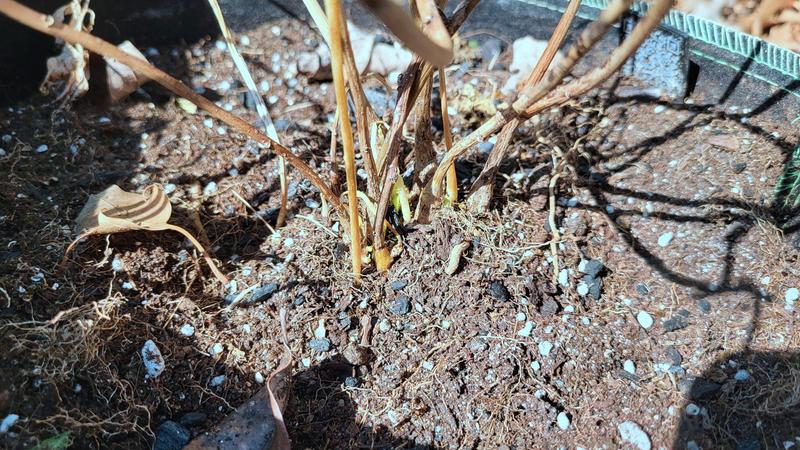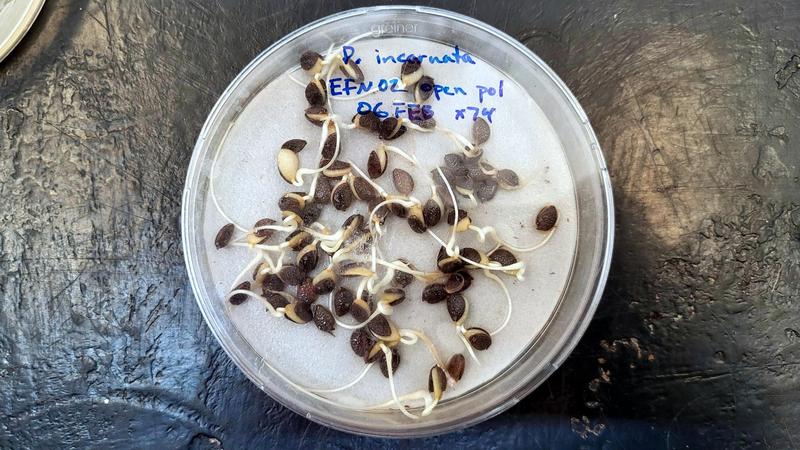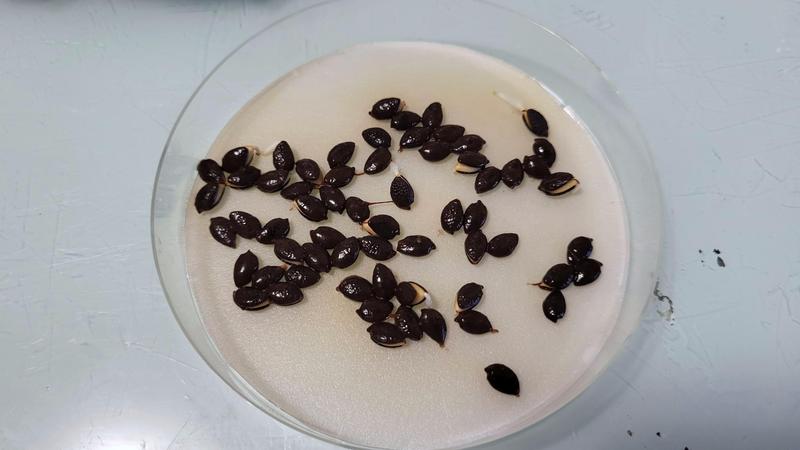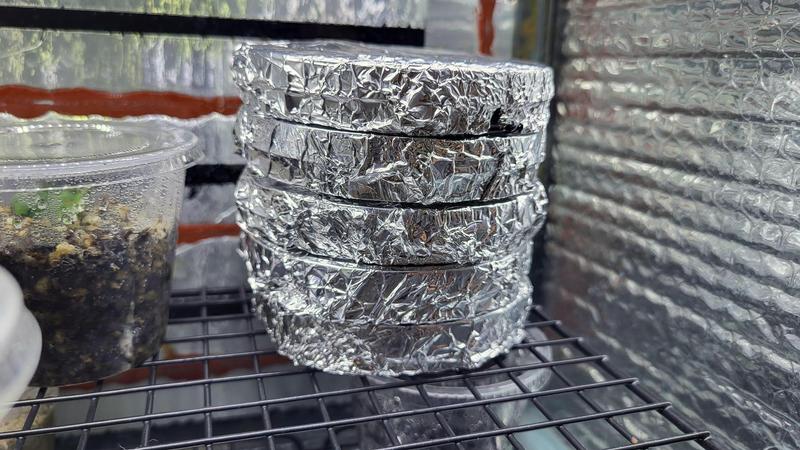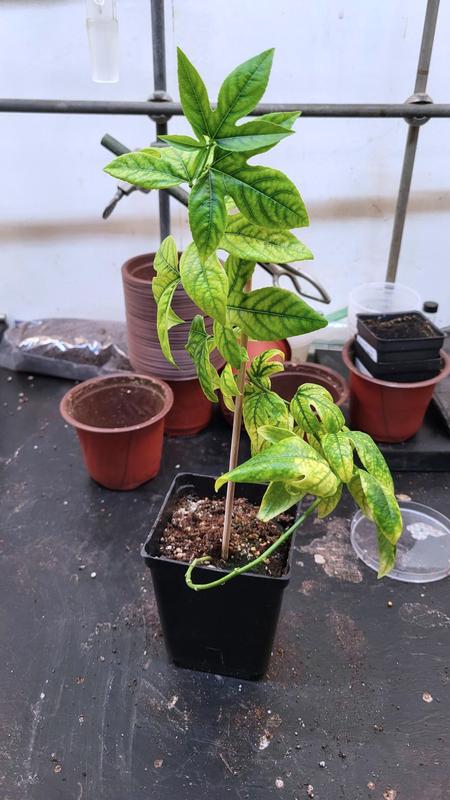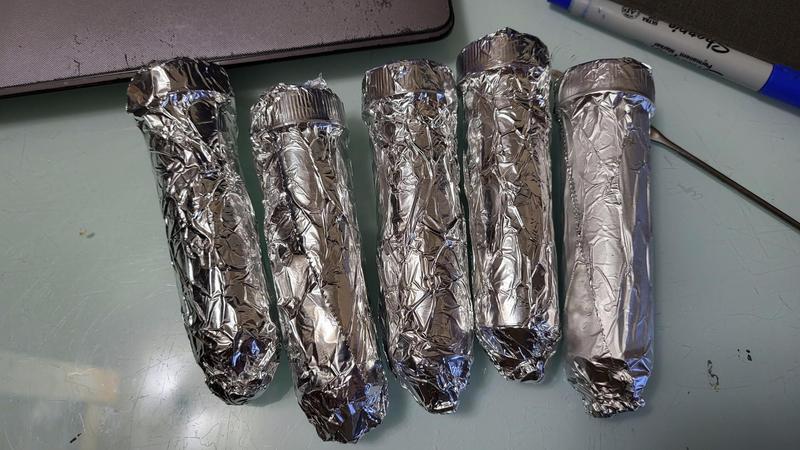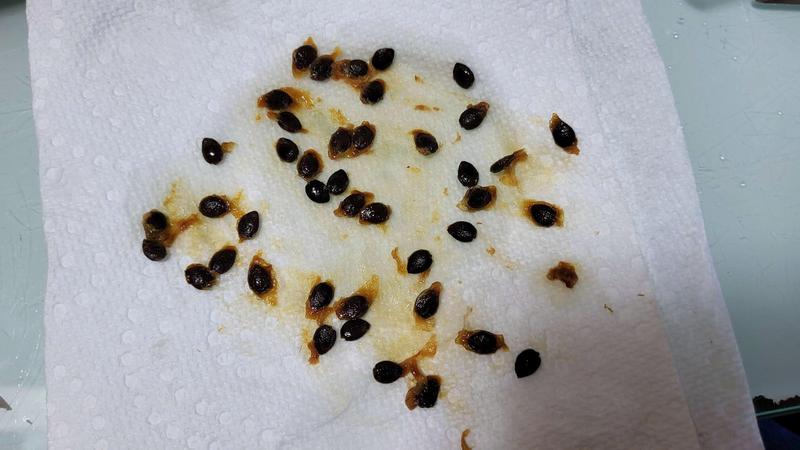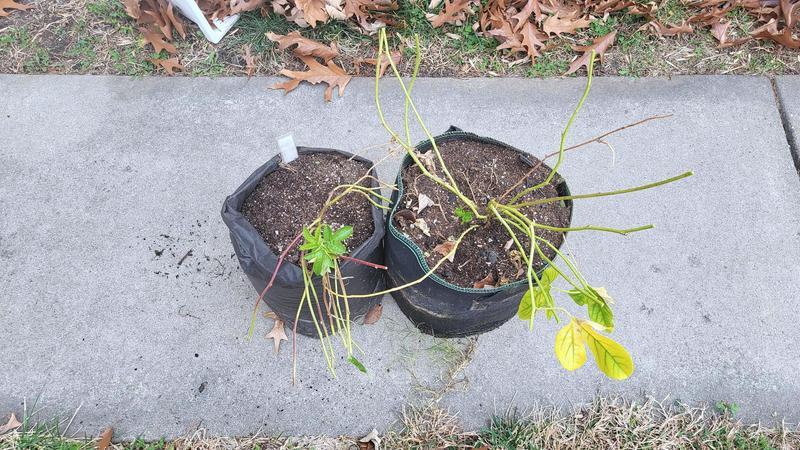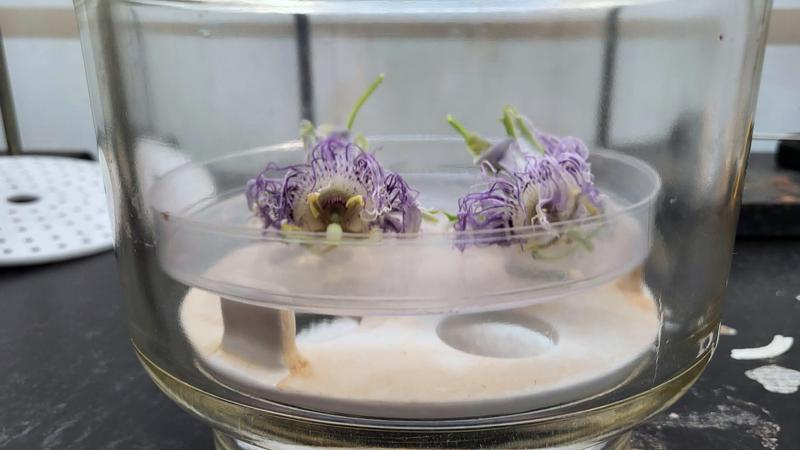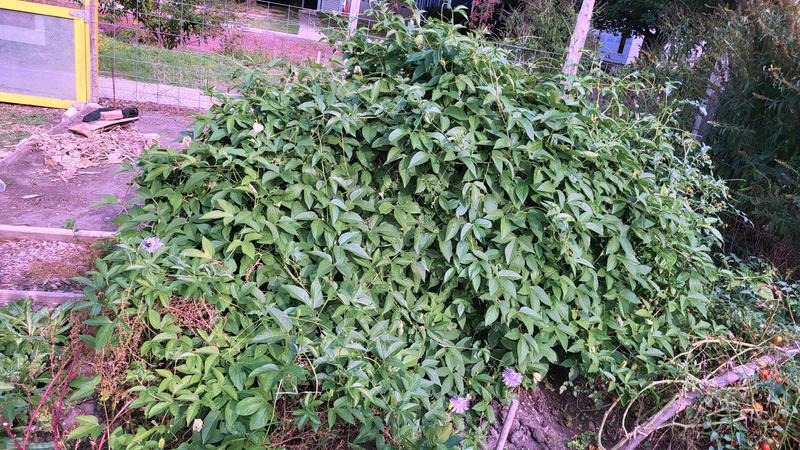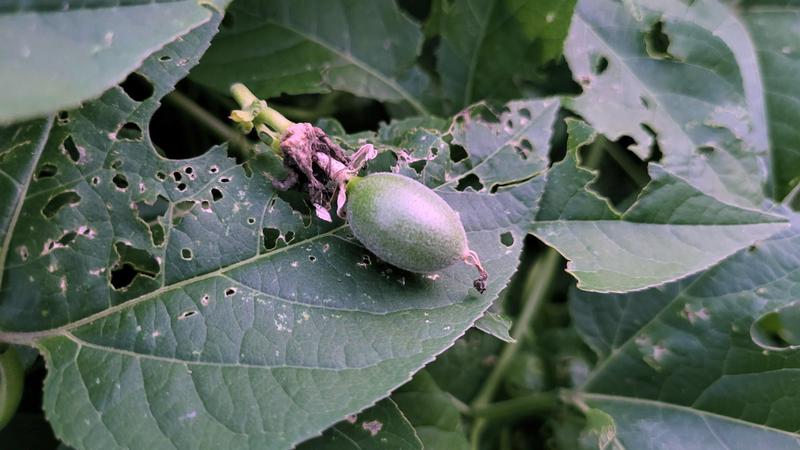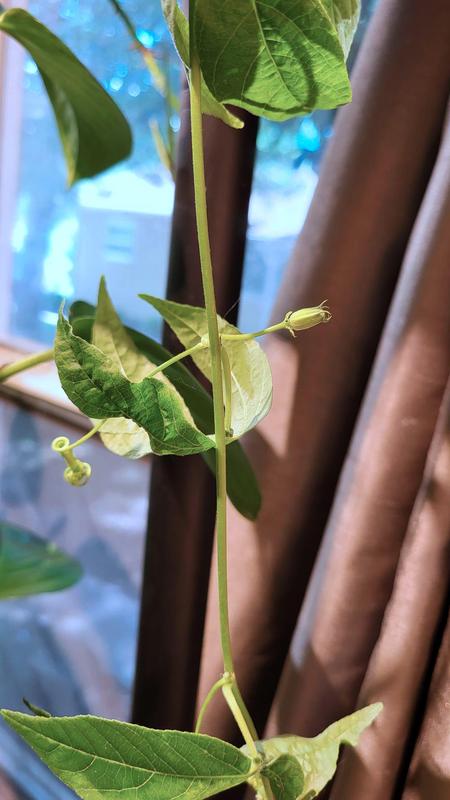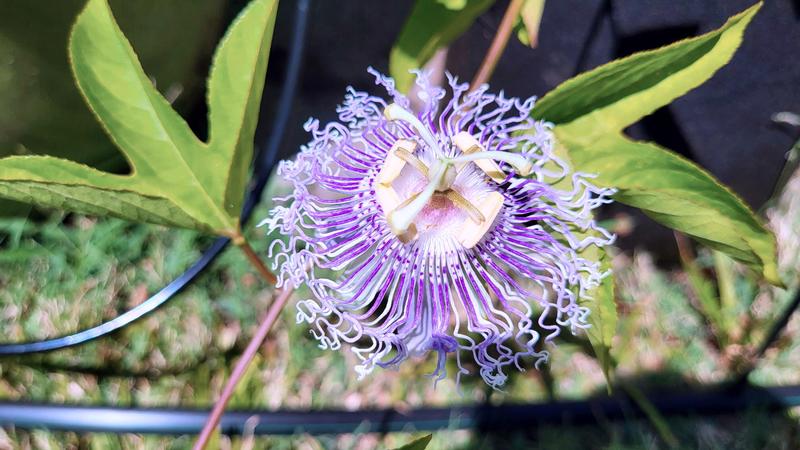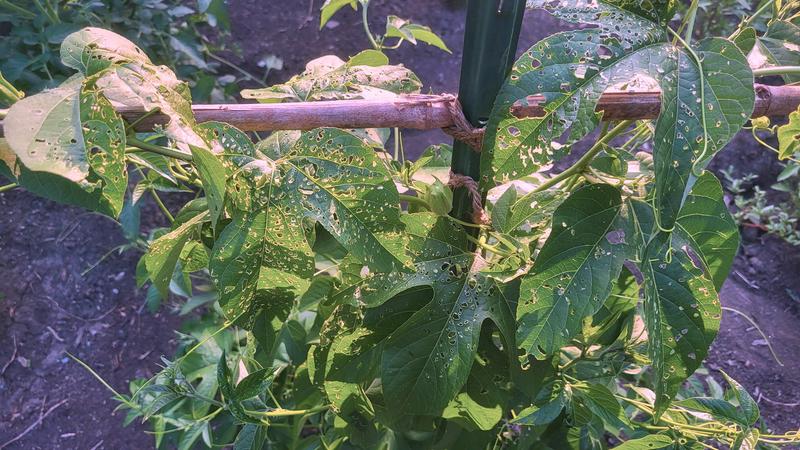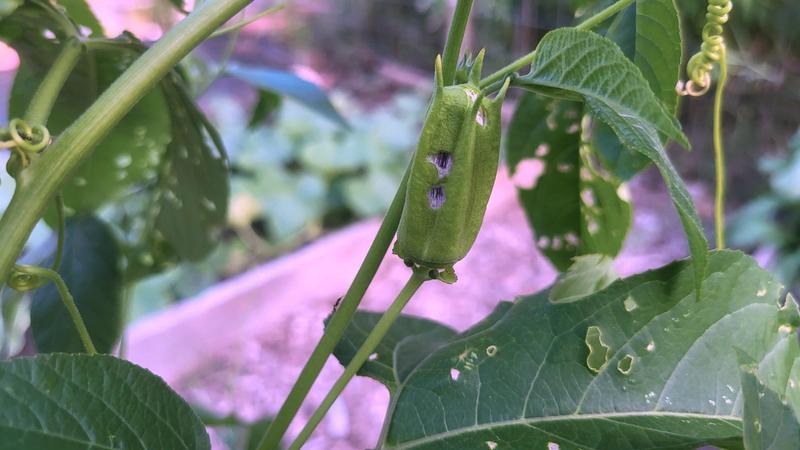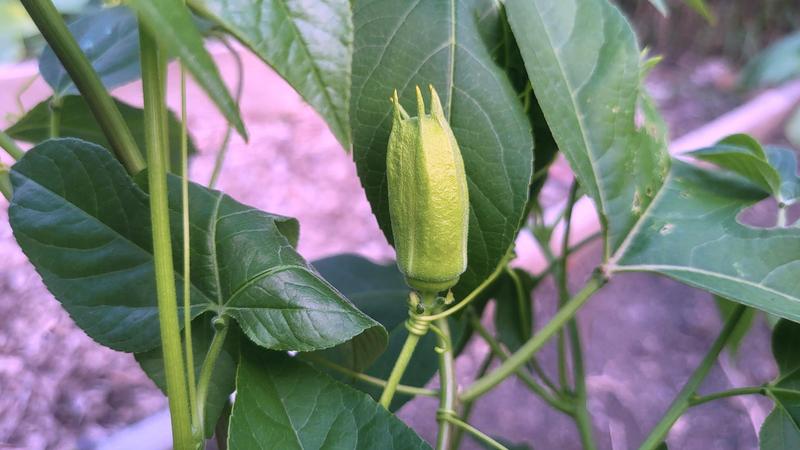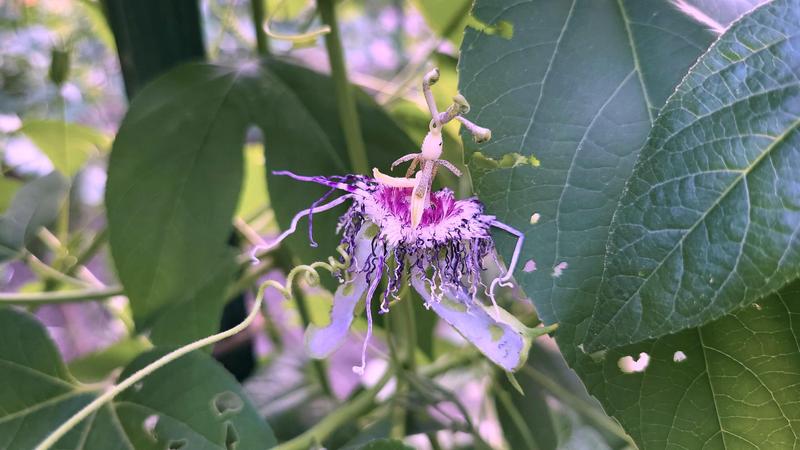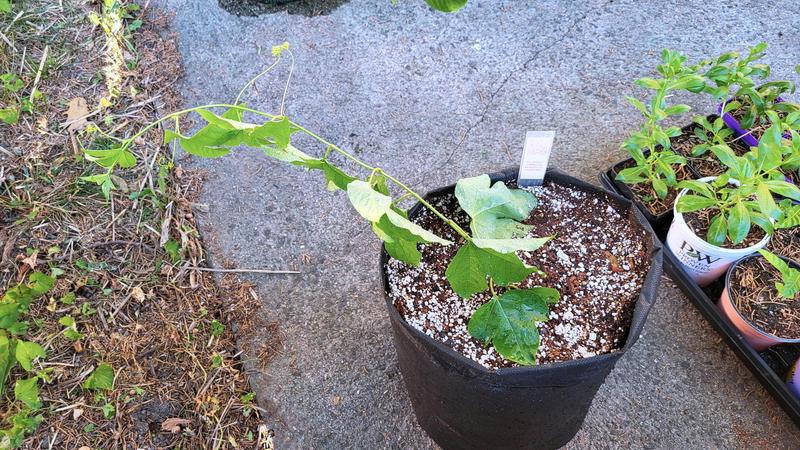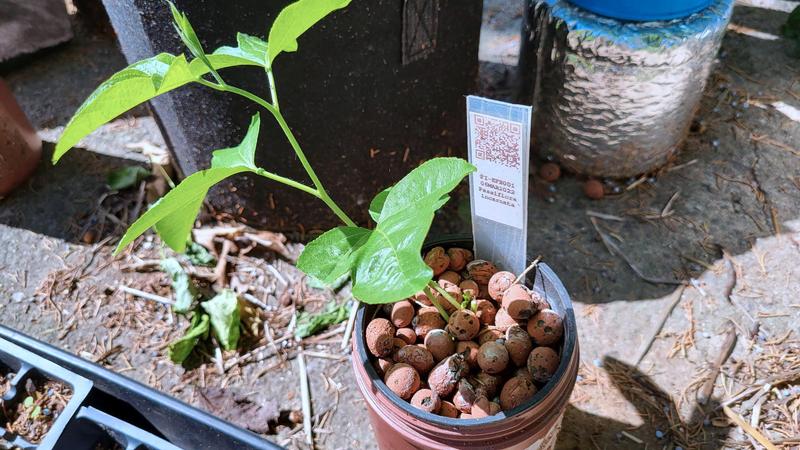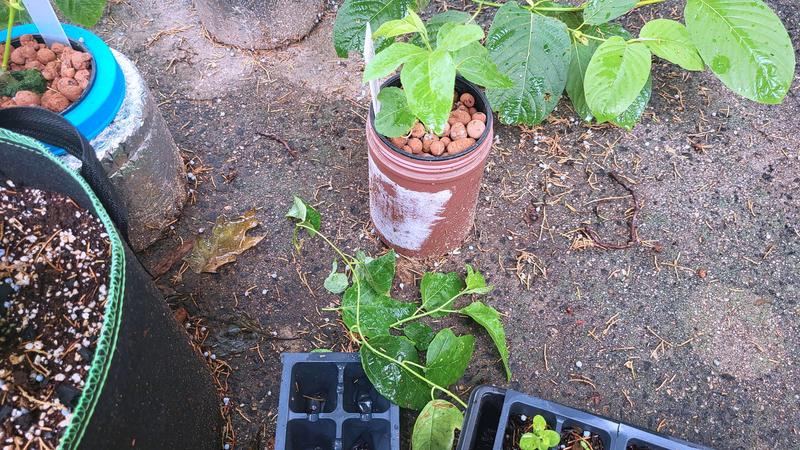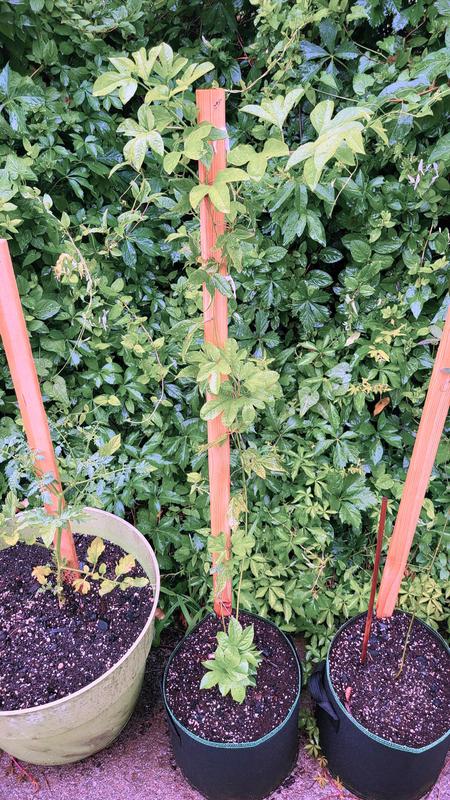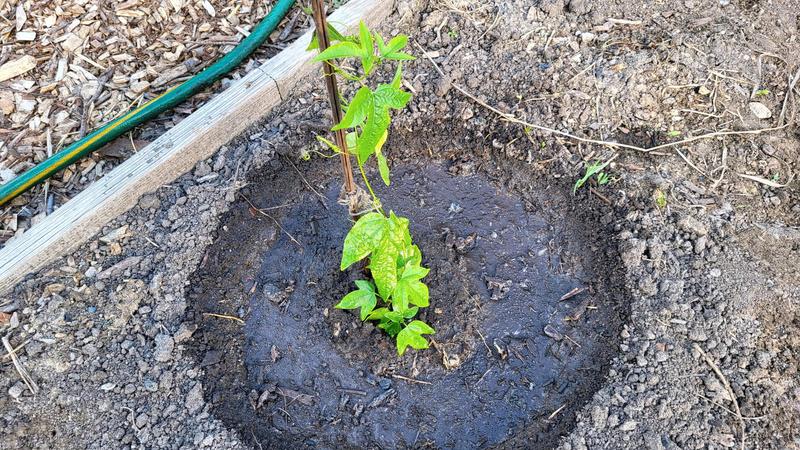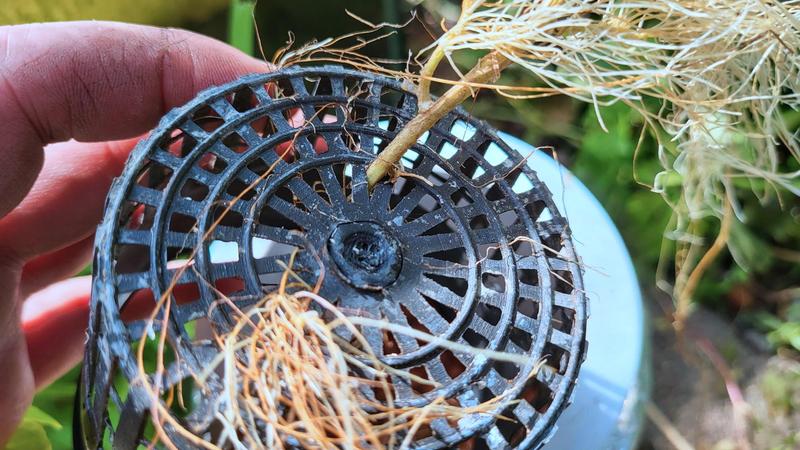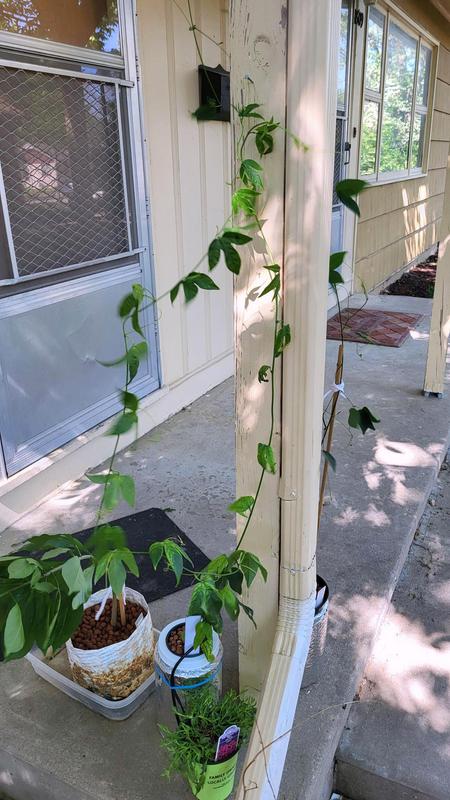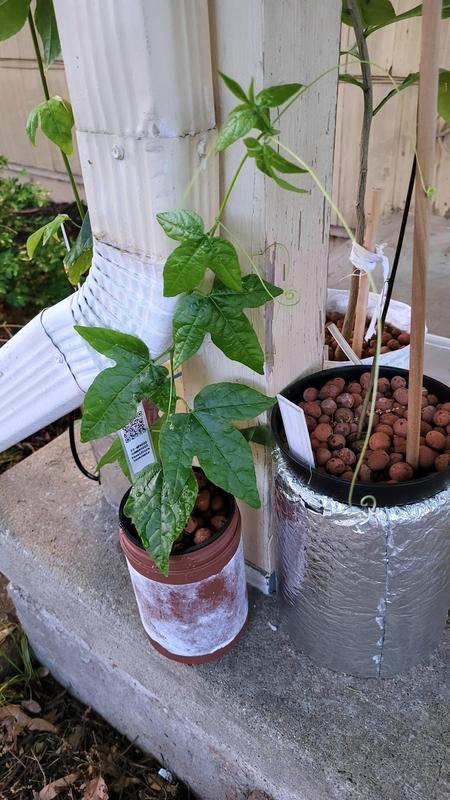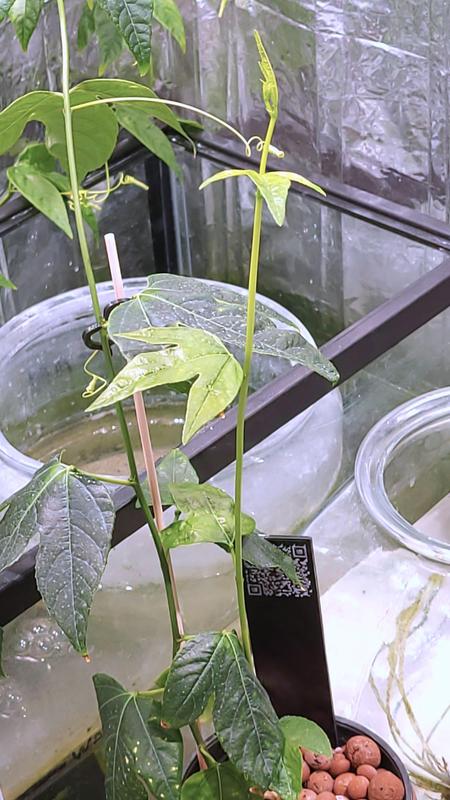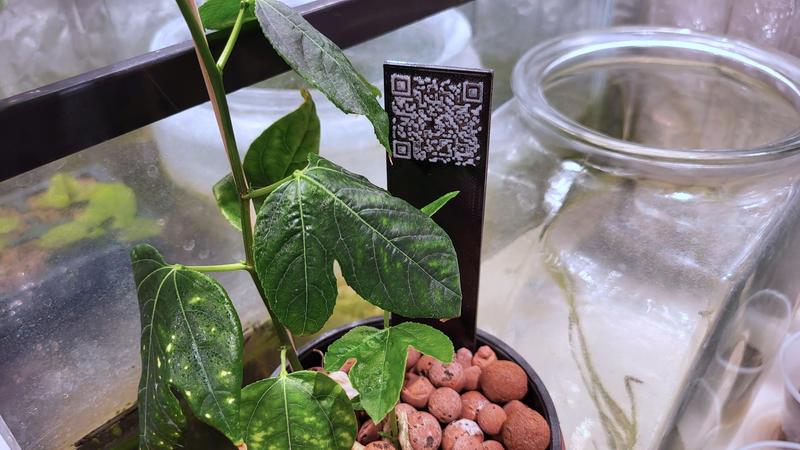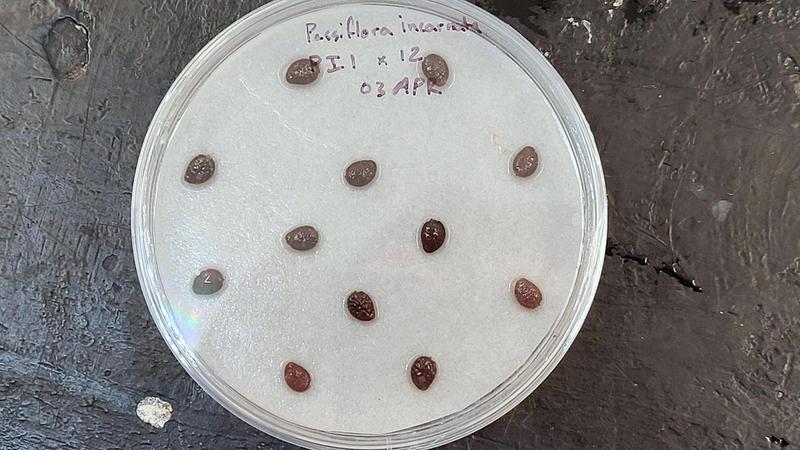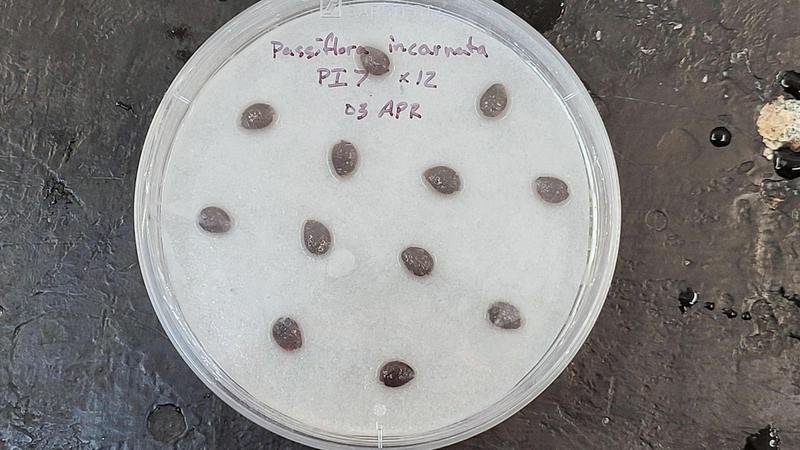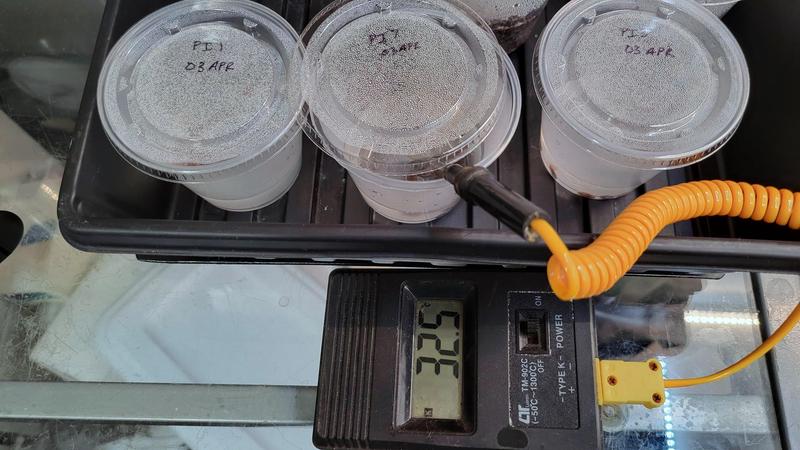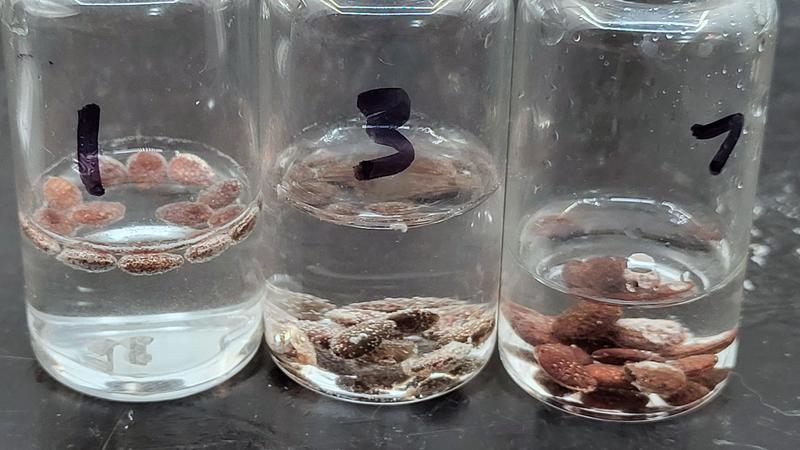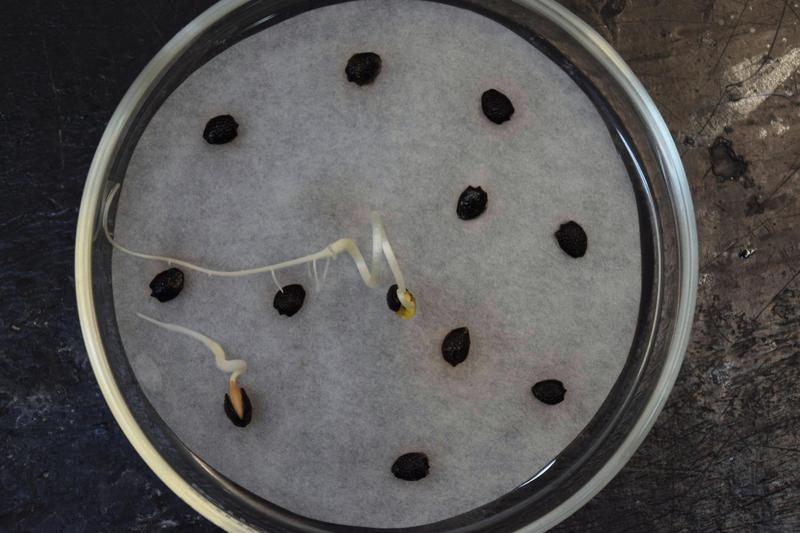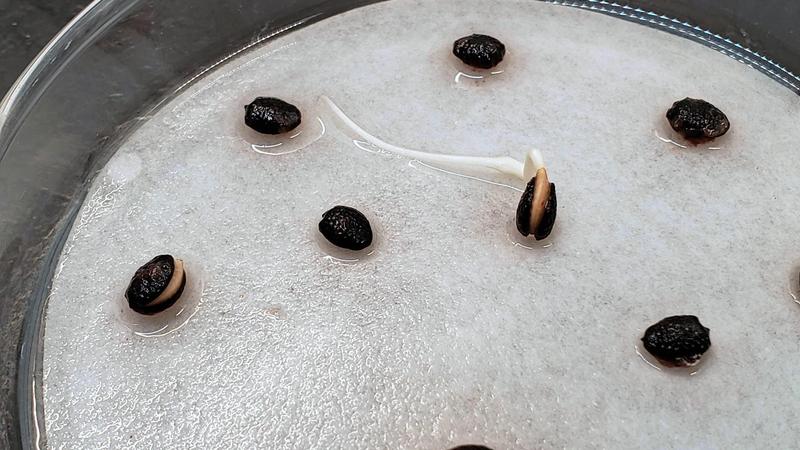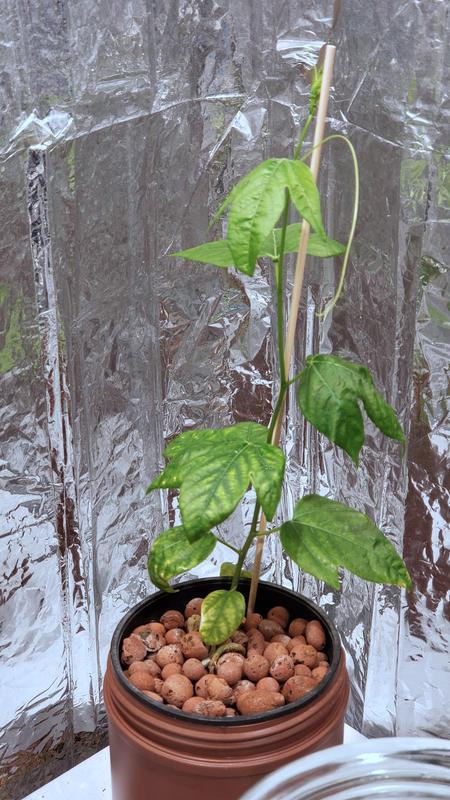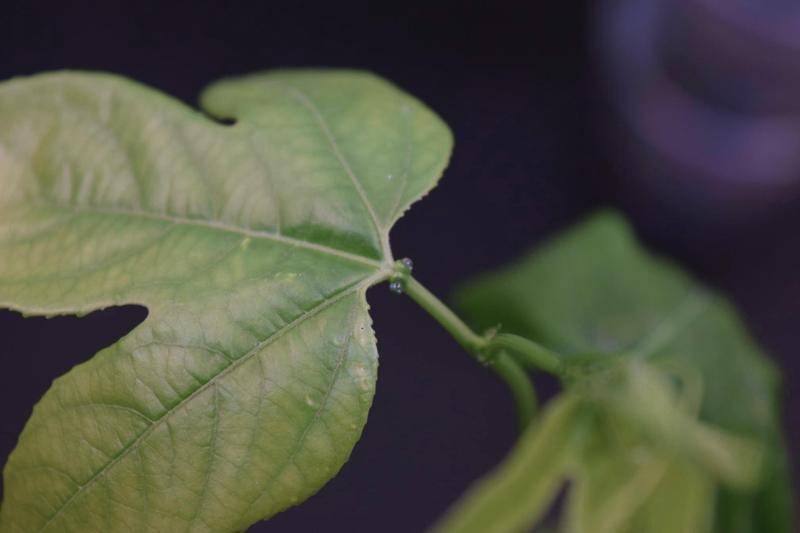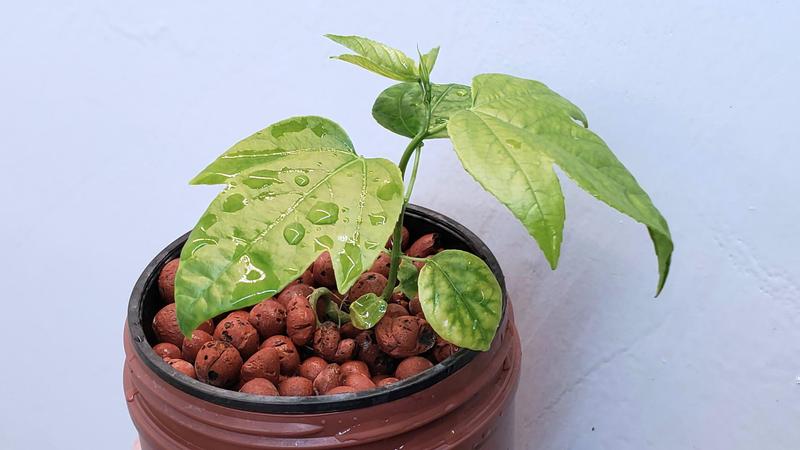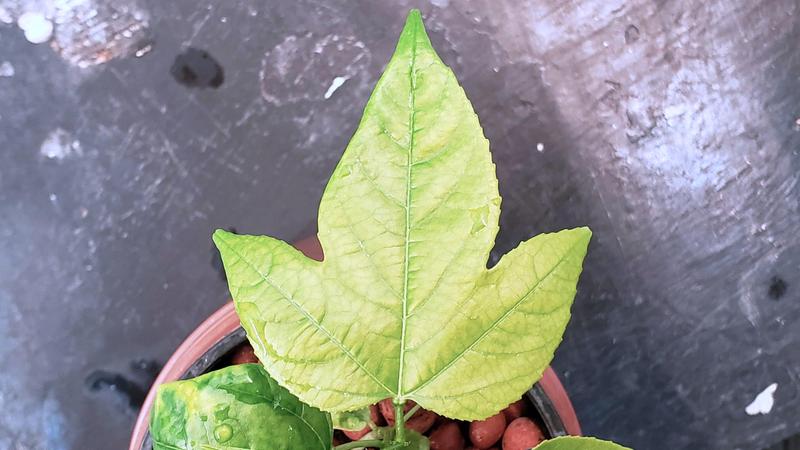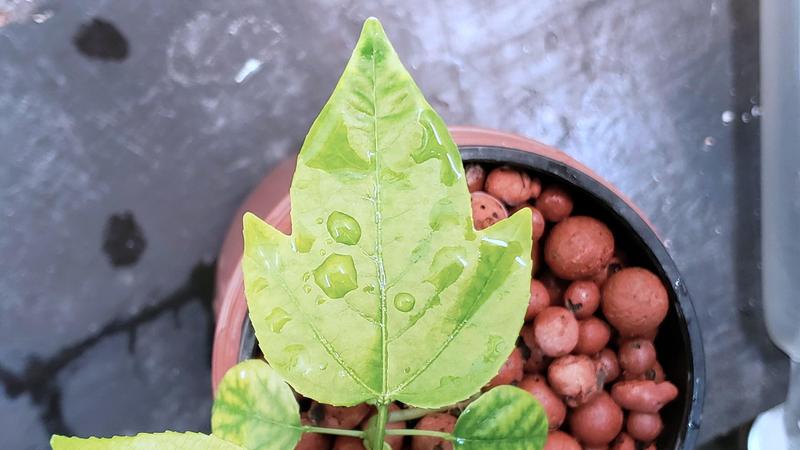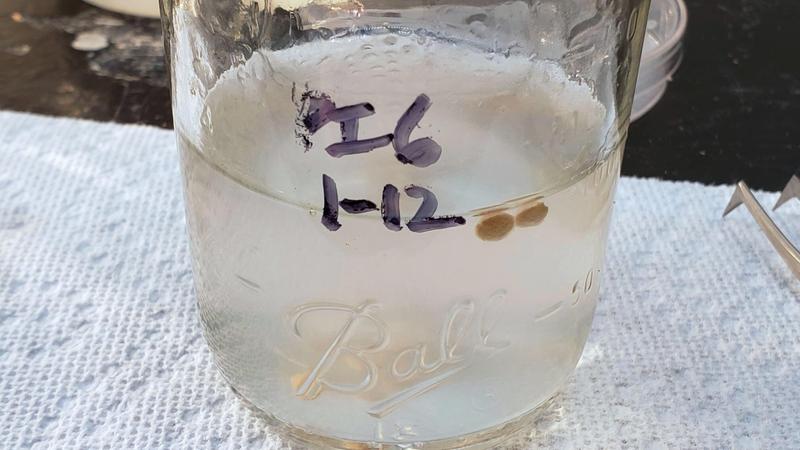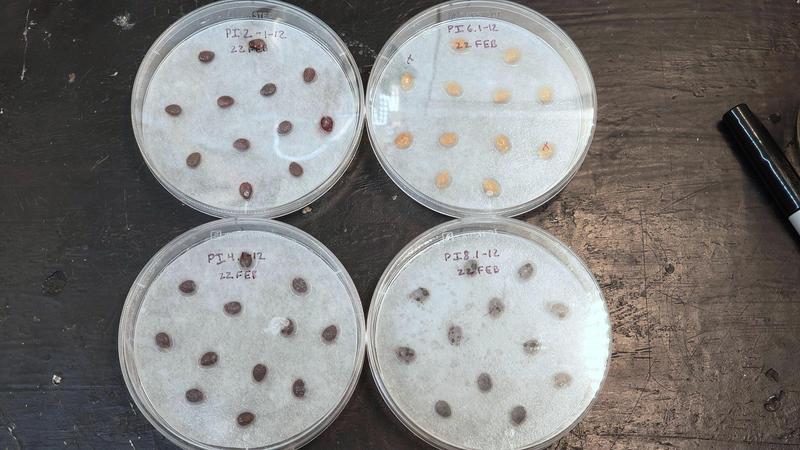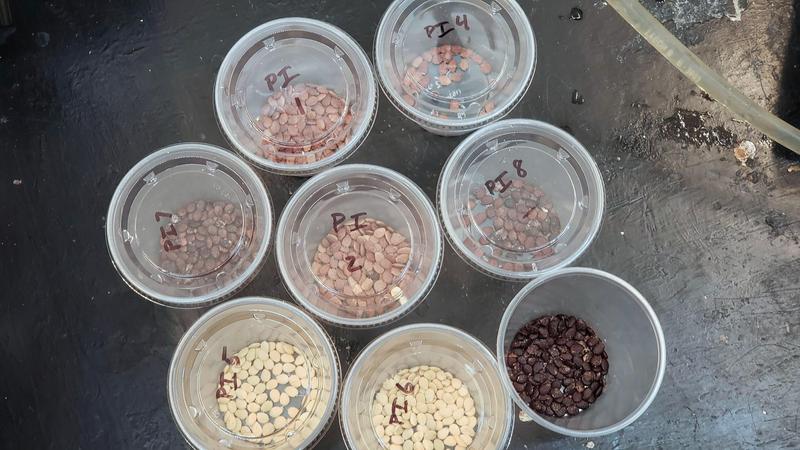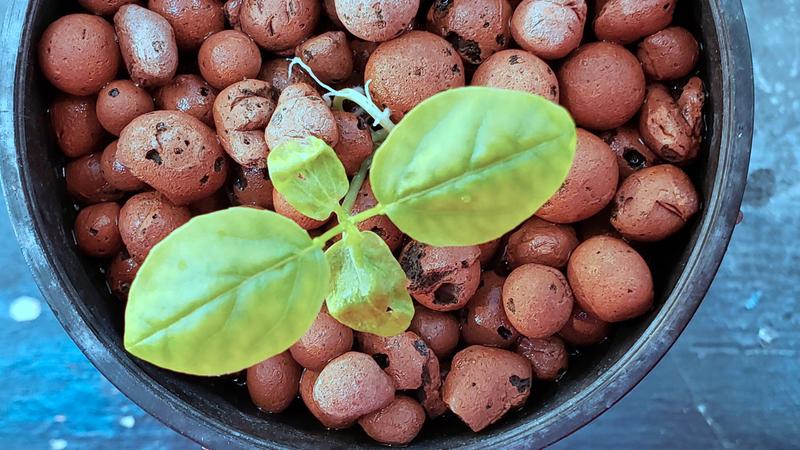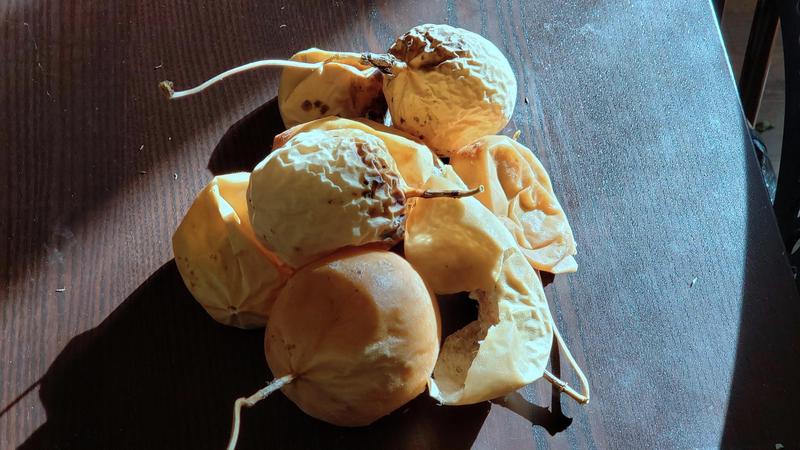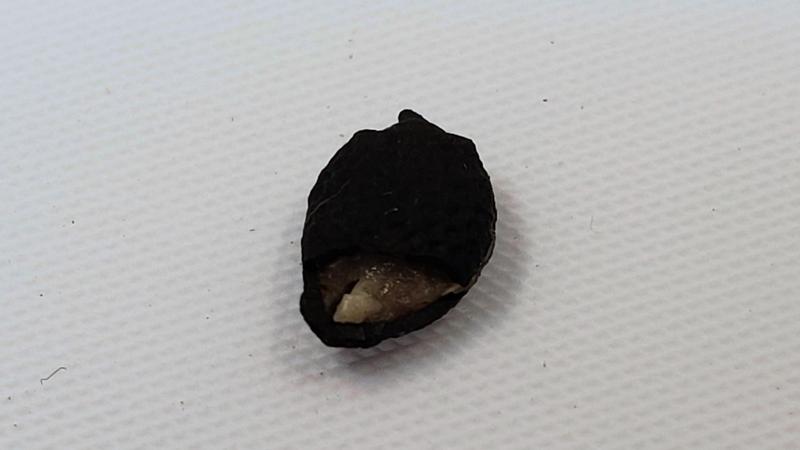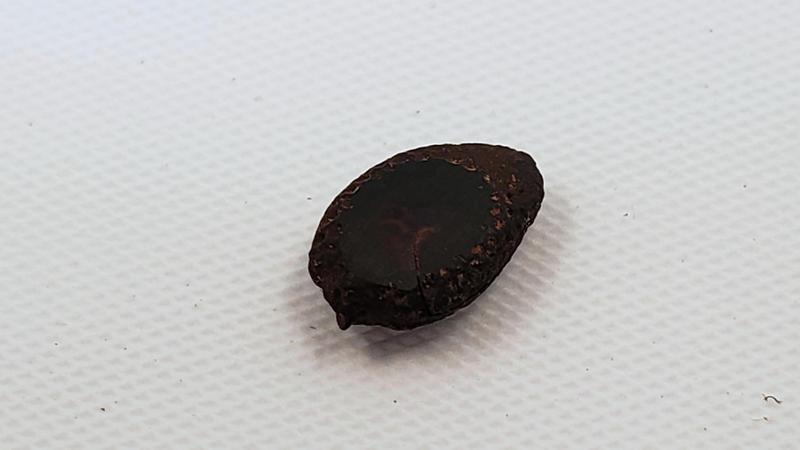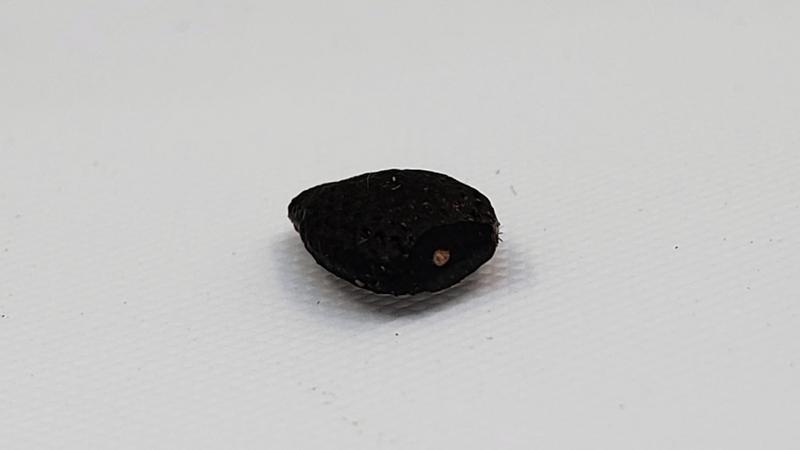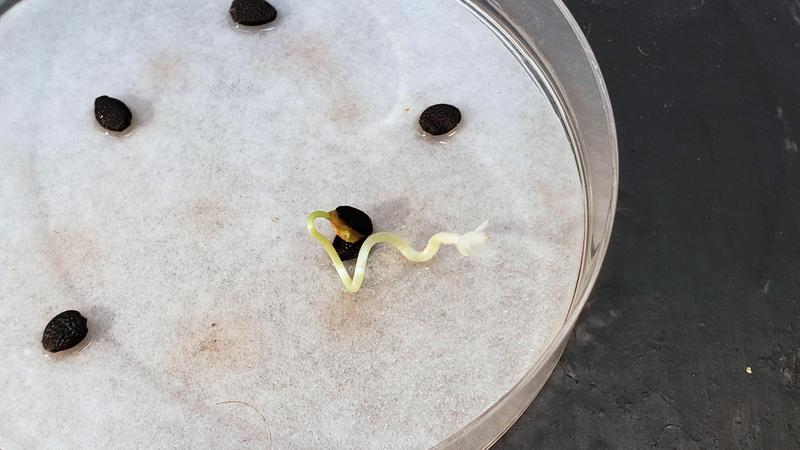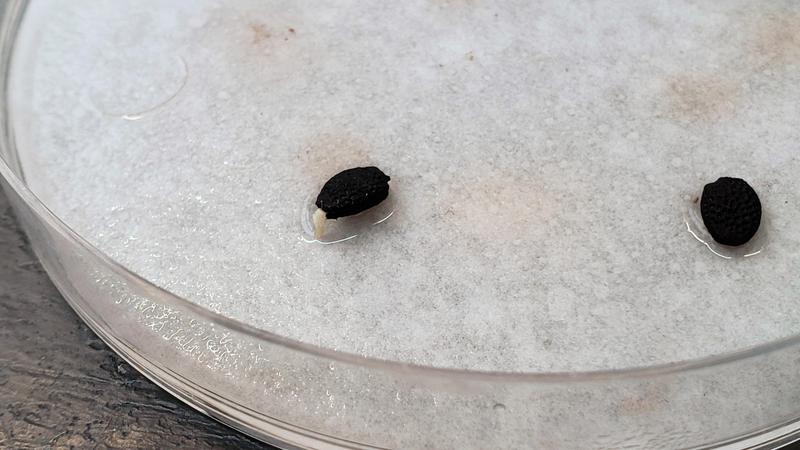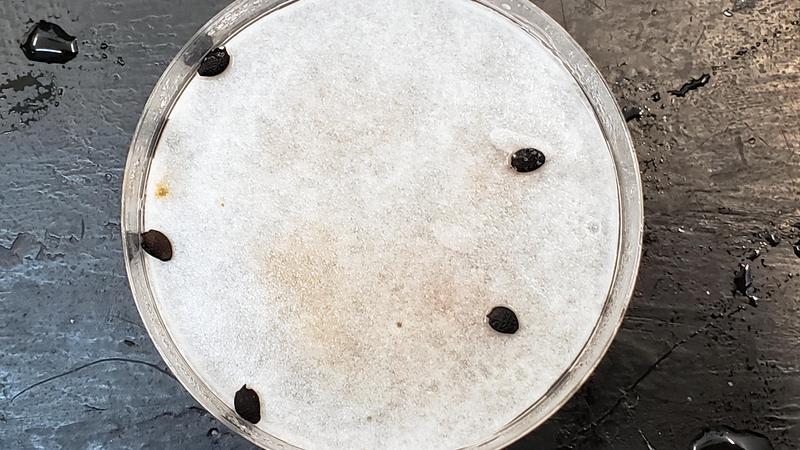Passiflora incarnata
Videos
Propagation
Flowers are sensitive to photosynthate resources, both local and whole-plant. Defoliation can increase the percentage of male flowers but not hermaphroditic ones. Likewise, the fruit set can be aborted to improve resource allocation in hermaphrodite production.[1]
Hermaphroditic flowers have styles and anthers at the same level. The styles of male flowers remain erect preventing pollen from entering the ovary. The styles of hermaphroditic flowers start initially in the erect position but descend for 1-2 hours. Less than 1% of male flowers produce fruit under natural conditions and only 6.5% in ideal, hand-pollinated conditions. Though they can sire fruit set just as well if not better than hermaphroditic flowers.[2]
At least five distinct gender categories have been noted but intermediates exist between these.[3]
P. incarnata is self-incompatible.[3][2][4]
Of the 122 flowers across the five P. incarnata genotypes from differing locations, none of them produced a fruit or had any indication of successful or partially successful fertilization when selfed, indicating strong self-incompatibility.[4]
Other Passiflora spp. can be self-incompatible or self-compatible. [5]
P. incarnata can reproduce via seed or rhizome.[6][2] Sexual reproduction is the primary means of spread.[7][8]
Incarnata can regenerate with 21% success from a 0.5cm root section. Four-centimeter sections regenerate with 100% success.[6]
Passiflora is a diverse genus and any propagation protocol is likely to be highly species-specific.[9]
Hybridization of Passiflora spp. to produce favorable cold tolerance in fruit-producing commercial varieties has been difficult. These hybrids are often sterile, producing few seeds and therefore little juice-filled arils.[10]
Germination
| media | germination | temperature °C | note | reference |
|---|---|---|---|---|
No germination is seen in either light or dark below 25°C. Germination is best achieved at 35°C in the dark. [11][12][13] Some varieties might respond positively or negatively to pre-germination treatments.[13]
The most important germination triggers are light and temperature. When these factors are suboptimal, poor germination can be mitigated by a combination of leaching, pre-chilling, or GA3 treatment.[13]
Not only is germination percent the best at 35°C in the dark, but it also occurs as one large spike instead of a gradual slope of germination events.[12]
The suppression of germination by light is less pronounced with increasing temperature. Five minutes of light exposure is insufficient to induce suppression (“high-irradiance response”). Twenty-four hours of 35°C exposure is sufficient to protect seeds from light-induced suppression of germination.[11]
(negative photoblasty)
The seeds of P. edulis contain endophytic bacteria bound tightly until germination.[14]
Most commercially grown species of Passiflora do not show signs of physical dormancy. Cryopreservation in liquid nitrogen can improve germination is some species.[15]
Seedling vigor in P. edulis is governed primarily by maternal genotype since two out of three alleles in the endosperm are from the mother plant. This likely translates to incarnata.[2]
Seeds can be planted at a depth of up to 6cm without hindering emergence.[6]
Presoaking seeds in water is used as the standard pre-germination treatment.[16]
Cultivars from the same study and in the same germination conditions have 65-84% germination rates. [13]
Some species of Passiflora are viviparous.[17]
Vegetative
Some incarnata respond positively to auxin treatment and some do not.[18]
In-Vitro
| basal media | supplements | source | target | note | reference |
|---|---|---|---|---|---|
Cultivation
| Planting density (m-2) | inter-row space (cm) | intra-row space (cm) | note | reference |
|---|---|---|---|---|
| 5.6 | 60 | 30 | fertilizer | [28] |
Soil pH (4.2-5.3), organic matter (13-27 mg L-1), cation exchange capacity (42-67 mmol L-1), sum of bases (9-40 mmol L-1), and the percentage of base saturation (19-65 mmol L-1) have little effect on the flavonoid content of P. incarnata.[29]
Leaves of P. incarnata are sensitive to ethylene accumulation.[30] Good air circulation might be necessary.
Harvest
Flavonoid biosynthesis does not seem to be greatly influenced by age, root development, or size. The reproductive stage does influence flavonoid concentration. Storage after harvest significantly reduces flavonoid concentration.[31]
The fruit, flowers, seeds, roots, and to a lesser extent, stems, have significantly lower concentration of active constituents. They should be considered adulterants to commercial medicinal products and separated during harvest.[31][32]
Yield
| product | source | yield per season (kg/ha) | note | reference |
|---|---|---|---|---|
| dry biomass | aerial part | 964-1130 | fertilizer | [28] |
| product | source | yield per plant | note | reference |
|---|---|---|---|---|
Soilless
Edulis can be cultivated in semi-hydroponic media composed of a 1:1 ratio of pine bark and vermiculite[33], 100% rice husk[34], 100% vermiculite[35], 100% washed sand[36], composted pine bark, absorbent polymers, sawdust, Umgeni sand [37]
Incarnata has been cultivated in a 3:2 mixture of pine bark:native sawdust (“double-grind”) and fertigated with traditional NPK fertilizer.[38]
Soil
| soil type | pH | C-content % | precipitation | temperature (°C) | altitude (m) | note | reference |
|---|---|---|---|---|---|---|---|
Incarnata is known to inhabit all kinds of soils.[39]
Fertilization
| type | rate | time | note | reference |
|---|---|---|---|---|
| poulty manure | 4.2 t/ha (125 kg N/ha) | pre-planting | fertilizer | [28] |
| bovine manure | 7.4 t/ha (125 kg N/ha) | pre-planting | fertilizer | [28] |
In low-phosphorus soil, P. edulis benefits from arbuscular mycorrhizal fungi.[40]
In field conditions, soil amendment with animal manure has complex effects on leaf antioxidant content. At the rate studies, no significant effect was seen on total production.[28]
P. incarnata is moderately tolerant to drought stress and can quickly recover from it. However, it prefers constant replenishment of water equivalent to evapotranspiration loss.[38]
Small amounts of silicon might be useful for mitigating plant damage, but the effect is rather weak and dose-dependent.[41]
Albit (a complex fertilizer mixed with Bacillus megaterium and Aureofaciens pseudomonas biomass) can increase the total number of leaves of P. incarnata but not the concentration of antioxidants.[42]
Temperature
Incarnata inhabits regions with an average frost-free period of 160-200 days.[39]
Lighting
| fixture type | photoperiod | illumination | note | reference |
|---|---|---|---|---|
Pests
Alternaria sp., Botrytis fabae, Cladosporium cladosporioides, Fusarium spp., and Lasiodiplodia theobromae are potentially pathogenic in Passiflora spp. Especially theobromae. [47] Except maybe certain strains of Fusarium oxysporum.[48]
Simulated herbivory increases the production of extrafloral nectar and leaf thickness.[49]
Ecology
At least 204 identifiable species of endophytic bacteria have been isolated from P. incarnata.[14]
From the plant’s RS, the isolated strains were identified mainly as belonging to the genera Sphingomonas, Curtobacterium, and Methylobacterium, whereas Bacillus was the dominant genus isolated from the vegetative stage (VS).[14]
Morphology
| character | measurement | unit | notes | reference |
|---|---|---|---|---|
Some confusion over the identification of P. edulis and P. incarnata exists. Morphological techniques can be used but are somewhat unreliable.[50][51] Microscopic, extractive, and chromatographic techniques can be used to distinguish the two.[51] More details can be found in Chinniah et. al.[52]
Roots
Incarnata has a strong tap-root that penetrates more than a meter into the soil. Roots showing signs of shoot growth occur mainly between 10 and 20 cm in depth but can extend as deep as 75 cm.[6]
Roots and rhizomes exist in about a 9:1 ratio. They cannot be distinguished by gross external anatomical features, differing only by the presence of a central core of the xylem or pith for roots or rhizomes, respectively.[6]
Stem
Leaves
Dark green, smooth, palmate, trilobed[50]
Papillose epidermis. Amphipericytic stomata. Simple unicellular trichomes. Sparse epicuticular wax. Undulating anticlinal wall.[50]
Inflorescence
Incarnata’s floral color patters have been described mathematically.[56] So have the temporal oscillations of flower production.[57]
Bluish white, five petals with white and purple corona.[50]
Indeterminant [10]
More than 10-fold variation in the numbers of flowers was noted in a study of wild and cultivated accessions of incarnata.[16]
Fruit
Green to orange oval fruit without bracts.[50]
Climacteric[30]
Seeds
Seed germination quality is affected by the mother plant more than the father, due to genomic effects in the endosperm.[58]
The seed set is reduced by self-incompatibility in field conditions. In Cuba, where root cloning is the preferred method of establishing new plantations, fruit set is rare.[59]
Phytochemistry
| compound | source | concentration (mg/g dry weight) | note | citation |
|---|---|---|---|---|
| polyphenols (GAE)1 | aerial biomass | 5.0-8.55 | fertilizer | [28] |
| flavonoids (RE)2 | aerial biomass | 11.5-15.0 | fertilizer | [28] |
| flavonoids (isovitexin equivalent) | aerial biomass | 15.6-44.0 | timecourse; distribution | [31] |
| harmine | aerial biomass | 0.000935 ± 0.00733 | extraction | [60] |
| harmol | aerial biomass | 0.031 ± 0.0373 | extraction | [60] |
| iso-vitexin | commercial sample | ND - 0.4397 | identification | [61] |
| vitexin | commercial sample | 0.016 - 2.301 | identification | [61] |
| harmol | commercial sample | ND | identification | [61] |
| harmane | commercial sample | ND - 0.000112 | identification | [61] |
| harmine | commercial sample | ND - 0.000271 | identification | [61] |
ND - Not Detected
About 20 species of passiflora are cultivated commercially. P. incarnata is of the most interest as a medicinal product because of its high production of secondary metabolites.[62]
Incarnata extract can be used as a pH indicator.[64]
There is substantial variation in commercial samples of dried raw material, extracts, and cultivated plants. The majority of commercial samples are dominated by isovitexin, however, some have higher levels of swertisin.[65]
Infraspecific Variation
Biosynthesis
Endophytic fungi are at least partially responsible for the antioxidant composition of P. incarnata.[48][68] The same for bacteria.[69][42]
Although it could be that the microorganisms have obtained those genes from the host plant.
Distribution
The leaves have the greatest accumulation of flavonoids. Fruits and seeds have very little active constituents. Similarly, stems have one-fifth the concentration of flavonoids compared to the leaves.[31] The anxiolytic effects of incarnata extracts in mice are in line with this distribution of flavonoids.[32]
Timecourse
The flavonoid content of incarnata aerial parts reaches 2% by the time cuttings reach 6-7 leaves. At the highest, the anthesis stage, the concentration reached 3.5-3.9%.[31]
Improvement
| trait | improvement status | reference |
|---|---|---|
Identification
| variety | description | reference |
|---|---|---|
Distinct chemotypes of incarnata exist. It is unknown what contribution the environment or genotype has on the distinction.[65]
Identifications in the mid to late 19th century cited P. edulis and P. incarnata as synonyms.[51]
Inheritance
Methods
| type | note | reference |
|---|---|---|
Harmala alkaloids can be purified by traditional AB extraction: acidification, washing with organic solvent to remove nonpolar impurities, neutralization, and extraction with ethyl acetate.[60]
Example Harmala Extraction
- grind 15 grams of dry plant material (stems, leaves, tendrils)
- add 75 grams of 3% acetic acid
- stir for 5 minutes
- filter (Whatman 4 filter paper)
- repeat extraction with acetic acid
- wash resulting liquid 3× with 50ml petroleum ether and 50ml ethyl acetate 4
- add saturaged sodium bicarbonate solution to neutralize 5
- extract 3x with 100ml ethyl acetate to remove harmala alkaloids
- dry EtOAc with sodium sulfate
- filter through cotton ball
- evaporate
[70] [65] [71] [72] [73] [31] [60] [74]
History & Society
Early reports suggested that incarnata was introduced circa 1609 by a sailor from Bologna.[53] However, later archaelogical evidence shows incarnata seeds present as far back as 1800 BC.[39]
Work Log
07 Jul 2023
I just love these flowers.
27 Jun 2023
The garden plant is expanding quickly.
…depite the ravages of the invasive Popillia japonica.
12 Jun 2023
More flower buds are showing.
09 Jun 2023
Positioned some plants to grow along the bato bucket system for shading the possibly-not-uv-resistant plastic parts.
06 Jun 2023
The garden plant leaves are huge!
04 Jun 2023
Moved traded plant to large fabric pot for the season.
28 May 2023
So many sprouts growing from the garden plant. This is going to be a hassle to remove them all.
21 May 2023
Garden plant growing fast now.
12 May 2023
The garden plant has returned! I thought for sure that it was dead and gone.
08 May 2023
The seedlings in trays have grown considerably. They are ready for transplantation now.
04 May 2023
I have so many seedlings that I have started guerilla planting them around my city. They are native to my region and great for pollinators, so I’m not introducing species or anything.
17 Apr 2023
The outdoor fabric pot plants have started to show new growth already.
12 Apr 2023
Moved crawlspace plants outside for the growing season.
06 Mar 2023
Second petri dish showing a stellar germination.
I guess these seeds really do well when you cultivate them correctly.
28 Feb 2023
Seedlings growing fast despite the algae.
13 Feb 2023
Well I guess I have plenty of sprouts.
Moved the sprouts to peat-based potting mix in 6-cell 1020 trays.
08 Feb 2023
Seeds moved to filter paper in petri dishes covered in foil and incubated at 30°C.
07 Feb 2023
I definitely didn’t remove all of the aril…
06 Feb 2023
Repotted LLI cutting. Same pot just different media with mixed in slow-release fertilizer.
Starting seeds for this year in addition to the saved plants and cuttings:
74 Seeds from EFN02 open-pollinated seeds were placed in a falcon tube with 50ml tap water for 48 hours of leaching in the 30°C incubator. The tube was wrapped in aluminum foil to block the light. The seeds were heavily soiled with aril and bits of paper towel that I used to dry them. I will probably change the water out after 24 hours.
63 seeds from WSS were placed in similar leaching conditions. These are much cleaner.
I am not 100% certain about the identification of these seeds. I didn’t label them properly in the beginning.
63 seeds from WSS001 first fruit (vial seeds). I did label these seeds properly so I am certain of their identity.
42 seeds from LLI fruit #1. These seeds were still gooey. I rinsed them briefly in running tap water before soaking them as usual.
76 seeds from LLI fruit #2. Same as #1.
Total 318 seeds from 5 fruit.
An example seed yield from one fruit:
10 Nov 2022
Most of the aerial parts of the outdoor plant in fabric pots was remove. It had mostly died back at this point.
Then they were moved the crawlspace under my house for overwintering. It stays above freezing there throughout the winter.
30 Oct 2022
A very tasty fruit.
16 Sep 2022
Put WSS001 × ?? seeds (open pollination) from my first fruit into a vial for storage.
I am attempting to freeze-dry a couple of flowers. -27.5 mmHg.
15 Sep 2022
Incarnata can grow to a very large bush in just a single season.
09 Sep 2022
Seeds from the first fruit have been removed from the arils (yum) and set out to dry in open air.
22 Aug 2022
I applied a slow-release fertilizer “Schultz Bloom” last week and the WSS fabric pot plant has responded well.
17 Aug 2022
Some fruits have developed in the garden.
One of my indoor cuttings has developed a flower pod.
24 Jul 2022
A fruit was waiting for me when I got home from my trip.
Thank the bees!
18 Jul 2022
A male P. incarnata flower.
15 Jul 2022
EFN-002 is doing the best out of all of the maypops. It is many times the size of the others. However, there is a significant Japanese beetle (Popillia japonica) problem in the garden. I’ve caught (and removed) several of them munching down on my maypop.
Luckily, there are still dozens of undamaged flower pods. Hopefully, I will catch one opening soon.
13 Jul 2022
EFN-001 is getting too large for the netcup just like WSS-001.
So it was moved to a fiber pot just like WSS-001.
27 Jun 2022
EFN-001 has recovered.
24 Jun 2022
EFN-001 had some stem damage. This might be from the wind or a small animal (probably a squirrel).
The stem has been placed in water to hopefully root.
23 Jun 2022
Leaf color and growth is not looking as good as I had hoped.
09 Jun 2022
After transplanting to potting mix in a fiber pot and acclimatization in the shade, WSS-001 is looking strong.
07 Jun 2022
Planted EFN002 cutting in the garden.
The net cups have restricted the root growth of WSS-001.
With some wiggling, they are free:
12 May 2022
The maypops are getting too big for the closet. They need to be moved outside.
Acclimating them to the heat before the full sun:
15 Apr 2022
After more diligent nutrient changes, WSS-001 has sent up a new shoot.
07 Apr 2022
No more seeds from the first EFN seeds (06 Mar) and none of the seeds from TWF have germinated. As a last resort, I have placed them in a plastic bag in the refrigerator for stratification. Probably a month.
06 Apr 2022
EFN-001 and EFN-002 are growing. 002 seems to be doing better than 001.
WSS-001 has developed some leaf discoloration. This is likely just a nutrient problem because I am somewhat lax in my nutrient changes.
04 Apr 2022
Sowed the seeds from EFN and local groups 1, 3, 7.
03 Apr 2022
Started the remainder of the EFN seeds: 14 total. One was tan and floated–it was discarded. I disinfected the seeds with 70% EtOH for 1 minute and then 0.6% sodium hypochlorite + Tween20 for 4 minutes. Soaked in tap water for 24 hours.
Also started local seeds from PI 1, 3, and 7 in the same manner.
I decided to place the local seeds into a 1020 tray over a hot pad with two layers of Reflectix insulation underneath. The temperature in the leaching cups reached 32°C, so that’s only a little bit better than my incubator at 30°C.
It is worth noting the floaters:
02 Apr 2022
Discarded all seeds from local seed batches. Nothing has happened after more than a month. I’m beginning to think that if a seed doesn’t sprout in the first few days, it won’t ever sprout.
21 Mar 2022
Transferred PI-EFN001 and PI-EFN002 to LECA Kratky hydroponics with 1/2 strength Masterblend nutrients. Inoculated with mycorrhizae.
20 Mar 2022
One seed showing signs of infection in EFN1-12: Discarded. Transferred remaining ungerminated seeds to new dish. Two germinated seeds remain.
Three seeds from PI8-1-12 were also infected: discarded; transferred.
19 Mar 2022
Started 13 seeds (emptied packet) from TWF. They were a little sticky, so I rinsed them a few times in tap water. Soaked in 30 ml tap water for 48 hours in the 30°C incubator.
18 Mar 2022
Two seeds from EFN1-12 have germinated.
15 Mar 2022
The EFN01 seed has sprouted.
12 Mar 2022
WSS01 is getting taller by the hour. It already needs a support “trellis”.
10 Mar 2022
Extrafloral nectary? from WSS01.
07 Mar 2022
Transferred EFN seeds to a Petri dish. One seed coat has already cracked open.
06 Mar 2022
Started 12 seeds from EFN. 40ml tap water for seeds weighing a combined 410mg. These seeds are noticeably thicker than the others I have used.
04 Mar 2022
Replaced the Germ01 nutrients with full-strength Masterblend.
No germinations so far on trial 4. One seed has been removed for developing a pin mold.
27 Feb 2022
Germ01 is looking good.
Tripart leaves look slightly different on the same plant.
22 Feb 2022
Two seeds from the local 6 group remained floating after the 48 soaking period. All other seeds have sunk.
All seeds have been sown in Petri dishes (12 per 90mm plate). The two floating seeds were marked with x’s.
The dishes were wrapped in aluminum foil and placed in the incubator at 30°C.
20 Feb 2022
Well, I’m calling it. The remaining trial 1,2,3 seeds have been discarded. Contamination was starting on several seeds and I want to make room for the new seeds I acquired. Three months is long enough to wait to determine that these seeds are nonviable, especially considering normal maypop germination occurs in less than two weeks.
Seeds have been extracted from the new maypop fruits. There was significant color variation between fruits.
Trial 4 has been started. Twelve seeds from local seeds 2,4,6,8 were randomly selected. Each group was washed briefly with 10% bleach and some soap. Then they were set to soak for 48 hours in darkness.
19 Feb 2022
A new leaf type has emerged.
13 Feb 2022
The first pair of true leaves have emerged.
I cut the corners from the greenhouse bag to start adapting the incarnata to low humidity.
10 Feb 2022
Acquired some Maypop seeds from a local. Someone posted on the Experimental Farm Network P. incarnata group saying that they were located in Northeast Kansas. I found them on Facebook (no direct message feature on EFN). As it turns out, they live just down the street from me.
So I biked to their house and they generously provided 8 desiccated maypop fruits. Considering my location on the absolute edge of the Maypop growing area, it is reasonable to assume that these are indeed Passiflora incarnata or at least something with hardy Maypop lineage.
08 Feb 2022
The first germination is developing well. I removed the stipule manually with tweezers.
03 Feb 2022
The leaves were looking a little dehydrated so I added a “greenhouse”.
I had been spritzing the leaves down with water 2-3 times per day, but this is much better.
30 Jan 2022
Germ01 leaves have grown a bit since the transfer. They are still stuck together by the dried stipule, though. I might remove that manually soon.
27 Jan 2022
The leftover seed coat from germ01 is interesting. It shows that each half of the seed coat is hard, yet friable. The median between the two is easily broken and probably why these seeds do not require scarification.
I also inspected the seeds from trial 1. I had intended to try physical scarification on the rest of the seeds to test my theory. However, at least one of the seeds appears to be mush on the inside. The seed coat was already cracked and I removed a bit of it to see what was inside.
The rest of the seeds have been scarified to some degree. One seed coat cracked under the weight of my finger against a file leading me to believe that seed was also mush.
I sanded the sides of some seeds.
Or sanded the end until the white color started to show.
So I think these seeds are mostly non-viable. I need to find a new seller.
I need a microscope.
26 Jan 2022
Transferred the first seedling to Kratky hydroponics. LECA and 1/4 strength Masterblend + magnesium sulfate + calcium nitrate fertilizer.
24 Jan 2022
Leaf structures have emerged.
22 Jan 2022
Hairy roots are developing.
21 Jan 2022
Maypop Passion Fruit Improvement Project | Experimental Farm Network
17 Jan 2022
First seed to germinate is from Trial 2.
09 Jan 2022
Started another 5 seeds. Leaching in 30 ml tap water for 24 hours. Placed in the incubator at 30°C covered in aluminum foil to block light.
07 Jan 2022
None of the seeds have germinated. I am worried that my PID temperature controller was off leading to a 6°C overcooking of the seeds.
Just now while I was reworking the nucifera growing chamber using the same PID controller that I used on the incubator, I noticed that the temperature was wildly inaccurate. A full 6°C below the actual temperature as measured by a calibrated glass thermometer. The previous P. incarnata seeds could have been incubating at 41°C the entire time as well as the A. peregrina, and the E. rheedii for a shorter time.
25 Dec 2021
I can’t tell if this is infected or just some mineral deposit on the seed coat.
Close up.
17 Dec 2021
Sowed 2nd trial seeds on filter paper in the dark incubator at 35°C.
16 Dec 2021
Started 2nd trial. Soak in distilled water for about 4 hours in the 35°C incubator under foil. Removed the integument. Soaked for 24 hours in the 35°C incubator under foil.
15 Dec 2021
Well.. it has been 12 days since sowing and two weeks since leaching. I am starting to think the seeds are non-viable. Given my success rate so far with this seed vendor, I am not surprised.
I might try some seed treatments that work for the related species: edulis and caerulea. I wouldn’t be surprised if the seed vendor misidentified incarnata.
P. caerulea is a cold-hardy species with an extended germination time. P. incarnata obtained from a reliable seed vendor began germination after one week, regardless of the treatment condition.[12]
Similar results were seen with seeds obtained directly by the researchers.[13][11]
Oddly enough one study on caerulea had better than 50% germination by day seven after sowing. However, those seeds were collected from “healthy plants that naturally grow on the campus of the Faculty of Sciences in Buenos Aires” with no indication of how they were positively identified.[75]
Earlier studies that also harvested natural seeds in Buenos Aires had much longer germination times.[76][77]
Given the difficulty in identifying Passiflora, it seems reasonable to hypothesize that the researchers could have misidentified these species.
The maturity and/or age of the harvested fruit could have contributed. Some amount of fermentation or drying of the fruit might be a trigger to germination.
One major difference between these results is the physical removal of the “integument at the basal (micropylar) end with pliers.” This is worth exploring.
- 3h soak
- removal of the integument
- 24h soak
03 Dec 2021
Sowed 5 seeds on filter paper in Petri dishes at 35°C in the dark.
02 Dec 2021
- 1.2 mM Ca (0.26g/L calcium ammonium nitrate)
- 0.7 mM Mg (0.17g/L magnesium sulfate heptahydrate)
The calcium and magnesium exchange solution for coir is fairly close to the standard calcium and magnesium portions of the Masterblend formula. [78] I think I’ll just go with that.
01 Dec 2021
19 seeds weigh a combined 0.59g (average 31mg per seed).
Starting leaching 5 seeds in tap water.
29 Nov 2021
While gathering nectar, Xylocopa circle around the androgynophore, contacting both anthers and stigmas with their thoracic dorsum.
That feels like a line from a dirty romance novel.
Maypop passionflower development was monitored using the rhizotron located at Auburn, AL. The rhizotron consisted of a cement-lined (3 sides) compartments 1.2 m long, 1 m wide, and 1.9 m deep. Inward slanted glass on one side permitted viewing of the root system.
Oooo… I want a “rhizotron”. That sounds so cool.
21 Nov 2021
Purchased Hopwood Farms (Illinois Growers Club?) Mycosphere Premium Mycorrhizae Blend amazon. It looks like kind of a shady product that came in a different package than pictured. The website doesn’t exist anymore… but whatever.
20 Nov 2021
Browsing mycorrhizal inoculants.
Dynamoco contain Glomus intraradices and mosseae. source
Xtreme gardening contains Rhizophagus irregularis.
Mycobliss has Rhizophagus and Claroideoglomus etunicatum.
Blueplanet Nutrients’ Root Magic has Glomus spp. and Bascillus spp.. source.
Glomus, Rhizopogon, Bascillus, Trichoderma, Scleroderma, Pisolithus
Bibliography
-
Spears Jr., E. Eugene and May, Peter G., Effect of Defoliation on Gender Expression and Fruit Set in Passiflora Incarnata, American Journal of Botany, vol. 75, no. 12, pp. 1842--1847, 1988.
doi: 10.1002/j.1537-2197.1988.tb11264.x.
We examined the effect of defoliation on gender expression and fruit set in a north-central Florida population of the andromonoecious vine, Passiflora incarnata, during the 1984 flowering season. At three times during the flowering season (May, June, July), the leaves adjacent to flowers at four stages of development were removed, and subsequent sex and fate of each flower were determined. Defoliation affected gender of the flower by significantly decreasing the probability that the styles of the flower would deflex and the flower would thus function only as a pollen donor. Flowers were sensitive to defoliation at any stage before anthesis, though the sensitivity appeared to decrease in the most mature category of flower buds. Fruit set of hermaphroditic flowers remained unaffected by defoliation, but the probability of fruit set and gender expression were significantly influenced by the time of the flowering season. We conclude that the local photosynthate environment determines flower gender in Passiflora, but branch or entire plant photosynthate resources can compensate for local resource fluctuations and play an important role in fruit set and flower bud abortion. The sexual lability of Passiflora incarnata appears to be an adaptation to uncertain resource levels at a fine scale, caused by nearby developing fruits and the possibility of herbivore defoliation.
-
Dai, Can and Galloway, Laura F., Male Flowers Are Better Fathers than Hermaphroditic Flowers in Andromonoecious Passiflora Incarnata, New Phytologist, vol. 193, no. 3, pp. 787--796, 2012.
doi: 10.1111/j.1469-8137.2011.03966.x.
• The diversity of plant breeding systems provides the opportunity to study a range of potential reproductive adaptations. Many mechanisms remain poorly understood, among them the evolution and maintenance of male flowers in andromonoecy. Here, we studied the role of morphologically male flowers (‘male morph’) in andromonoecious Passiflora incarnata. • We measured morphological differences between hermaphroditic and male morph flowers in P. incarnata and explored the fruiting and siring ability of both flower types. • Male morph flowers in P. incarnata were of similar size to hermaphroditic flowers, and there was little evidence of different resource allocation to the two flower types. Male morph flowers were less capable of producing fruit, even under ample pollen and resource conditions. By contrast, male morph flowers were more successful in siring seeds. On average, male morph flowers sired twice as many seeds as hermaphroditic flowers. This difference in male fitness was driven by higher pollen export from male morph flowers as a result of greater pollen production and less self-pollen deposition. • The production of male morph flowers in P. incarnata appears to be a flexible adaptive mechanism to enhance male fitness, which might be especially beneficial when plants face temporary resource shortages for nurturing additional fruits.
-
Krosnick, Shawn E. and Perkin, Joshuah S. and Schroeder, Tim S. and Campbell, Lesley G. and Jackson, Elizabeth B. and Maynord, Silas C. and Waters, Christopher G. and Mitchell, Jeffrey S., New Insights into Floral Morph Variation in Passiflora Incarnata L. (Passifloraceae) in Tennessee, U.S.A., Flora, vol. 236--237, pp. 115--125, November 2017.
doi: 10.1016/j.flora.2017.10.005.
Passiflora incarnata is a functionally andromonoecious clonal wildflower, native to the southeastern United States, whose primary pollinator is the carpenter bee, Xylocopa virginica. While recent studies looking at reproductive ecology in P. incarnata have classified flowers as one of two morphs (male or hermaphroditic) based on stylar deflexion, preliminary field studies conducted in Tennessee indicated there were five distinct morphs present (three male, two hermaphroditic), supported by stylar deflexion, floral size, and pistil development. The present study sought to test the hypothesis that five distinct floral morphs are present in P. incarnata by sampling 13 floral characters, and to document variation in nectar constituents, volume, and concentration across the five morphs. Five well-established individual plants were examined at three sites in Cookeville, Tennessee. Two-factor permuted analysis of variance of 13 floral characteristics with floral morph and individual plants as factors suggested that morph:plant interactions explained 6\%, individual plant explained 18\%, and floral morph explained 36\% of variation in floral characteristics. Nectar sampling indicated that all morphs produced nectar comprised exclusively of sucrose. Nectar volume generally increased with floral morph size, while nectar concentration decreased. NMDS analysis indicated that four of the five hypothesized morphs were supported as distinct, with morphs 4a and 4b best classified as submorphs due to substantial overlap. The supported morphs are best distinguished by ovary width, ovary length, style length, and stigma width. These findings support a hypothesis that the morphs result from variation in developmental arrest during floral ontogeny. The ecological implications of the morphs and nectar variation are considered for X. virginica with suggestions for additional studies.
-
Stafne, Eric T., Controlled Pollination to Assess Intraspecific Compatibility Among Passiflora Incarnata Genotypes from Different Provenances, HortScience, vol. 57, no. 8, pp. 919--924, August 2022.
doi: 10.21273/HORTSCI16658-22.
Passiflora incarnata L., commonly known as maypop, is a wild passion fruit native to many areas of the eastern and southern United States where the climate ranges from subtropical to temperate. Although P. incarnata has had little attention paid to it for breeding purposes, it could be used in breeding for fruit production and possibly contribute cold hardiness genes in combination with other Passiflora species. The study was performed in 2018, 2019, and 2021 at the Mississippi State University South Mississippi Branch Experiment Station in Poplarville, MS, United States. Passiflora propagules were collected from various locations: Florida (FL), Illinois (IL), Mississippi (MS), Missouri (MO), and Oklahoma (OK). Of the 122 flowers across the five P. incarnata genotypes from differing locations, none of them produced a fruit or had any indication of successful or partially successful fertilization when selfed, indicating strong self- incompatibility. If self-compatibility does exist in nature, it is likely to be rare. However, certain combinations of P. incarnata from different locations produced successful fruiting, including IL × MO (52\% success), FL × MO (85\%), FL × OK (80\%), MS × OK (40\%), MO × IL (50\%), MO × OK (40\%), and OK × MO (80\%). The differences across provenances show that incompatibility exists within P. incarnata but can depend on location. Overall, fruit weight, fruit size, and soluble solids content measured in this study were similar to and, in some cases, greater than those previously reported. These differences help to illustrate the diversity within P. incarnata and the still-untapped potential for breeding improvements. The problem of self-incompatibility is complex and there is much to learn about how Passiflora species, especially P. incarnata, function. Much of the U.S. domestic market is not familiar with passion fruit, especially as a table fresh product. This could be a barrier to adoption, but it could also prove to be an opportunity to create a niche within the present market and expand it. Although maypop fruit quality is not equal to that of Passiflora edulis Sims, selecting superior wild genotypes with desirable attributes to be used in future intra- and interspecific breeding is possible based on the results of this study.
-
Duarte, Mariana Oliveira and Alves, Mariana Ferreira and Yamamoto, Marcela and Sano, Sueli Matiko and Barbosa, Ana Angélica Almeida and Oliveira, Paulo Eugênio, Self-Sterility and Self-Fertility of Passiflora L. (Passifloraceae) in the Cerrado of Central Brazil, Brazilian Journal of Botany, vol. 37, no. 1, pp. 61--68, March 2014.
doi: 10.1007/s40415-013-0041-2.
Many species of wild passion fruit are used for the genetic breeding of passion fruit crop and kept in germplasm banks. This study investigated floral biology, breeding system, and chromosome number of Passiflora species that occur in areas of Cerrado in Uberlândia, Minas Gerais, from 2008 to 2010. In general, the species bloomed in the rainy season, the anthesis was diurnal, except for P. tricuspis, and flowers were open from 6 to 12~h. At the time of flower opening, the nectar was already accumulated in the nectariferous chamber. Protandry occurred only in P. tenuifila. Bees were the main flower visitors of these species. There were significant differences in the diameter and length of the floral androgynophore among species. Passiflora amethystina, P. tenuifila (both subgenus Passiflora), and P. suberosa (subgenus Decaloba) were self-fertile, while P. cincinnata (subgenus Passiflora) and P. tricuspis (subgenus Decaloba) were self-sterile, which contrasted with the usual trends in the group. The chromosome number for P. tricuspis was 2n~=~12, P. amethystina and P. tenuifila were 2n~=~18 chromosomes, and P. suberosa was 2n~=~24 chromosomes, which conformed to the recorded results for the group. Overall conservative chromosome numbers, and self-fertility in P. amethystina are interesting results for breeding programs and basic information for conservation.
-
Wehtje, Glenn and Reed, Russell B. and Dute, Roland R., Reproductive Biology and Herbicidal Sensitivity of Maypop Passionflower (Passiflora Incarnata), Weed Science, vol. 33, no. 4, pp. 484--490, July 1985.
doi: 10.1017/S0043174500082709.
Studies were conducted to evaluate seed and root reproduction and herbicide sensitivity of maypop passionflower (Passiflora incarnata L. ♯ PAQIN). Water-leached seeds that were not exposed to light had the greatest germination (53\%). Depending on soil type, seedlings emerged from depths of 10 to 12 cm. Most rapid germination and seedling development occurred between 30 and 35 C. Plants rapidly produced an extensive system of lateral roots and rhizomes that had regenerative capability at maturity. Root or rhizome sections of only 0.5 cm in length had a 20\% regeneration rate. Desiccation effectively reduced viability of root and rhizome pieces. Effective herbicide control was limited to the triethylamine salt of triclopyr \{[(3,5,6-trichloro-2-pyridinyl)oxy] acetic acid\} at 2.2 ai kg/ha, alkanolamine salt of 2,4-D [(2,4-dichlorophenoxy)acetic acid] at 1.7 kg/ha, and dicamba (3,6-dichloro-o-anisic acid) at 0.3 to 0.6 kg/ha.
-
Foré, Stephanie A. and Spira, Timothy P., Macrogeographic Allozyme Variation in Passiflora Incarnata, The Journal of the Torrey Botanical Society, vol. 129, no. 4, pp. 326--330, 2002.
doi: 10.2307/3088703.
Passiflora incarnata L. (Passifloraceae) is native to the southern United States and common in old fields and roadsides. This herbaceous, perennial vine has hermaphroditic flowers yet is self-incompatible. Large bees pollinate these flowers that produce fruits that may be eaten by mammals. Although the mode of sexual reproduction suggests the potential for long distance dispersal of genes, this species also displays extensive vegetative reproduction from rhizomes. Vegetative reproduction may reduce the amount of genetic variation within a population and increase differentiation among populations. We report on the macrogeographic allozymic variation within P. incarnata. Plants were collected from three regions in South Carolina (SC) and Georgia (GA). Genetic data were collected from nine polymorphic loci with starch gel electrophoresis of allozymes. In our sample of 168 plants from SC and GA, we observed 82 different multilocus genotypes. Plants with the same multilocus genotype were collected within and among regions. Genetic data indicated that there was little genetic differentiation among regions. These data suggest that there is extensive long distance transport of genes and that the species may rely heavily on sexual reproduction to establish new habitat.
- Tague, Rebecca T and Foré, Stephanie A, Analysis of the Spatial Genetic Structure of Passiflora Incarnata in Recently Disturbed Sites, Canadian Journal of Botany, vol. 83, no. 4, pp. 420--426, April 2005. doi: 10.1139/b05-014.
-
Faleiro, Fábio Gelape and Junqueira, Nilton Tadeu Vilela and Junghans, Tatiana Góes and de Jesus, Onildo Nunes and Miranda, Diego and Otoni, Wagner Campos, Advances in Passion Fruit (Passiflora Spp.) Propagation, Revista Brasileira de Fruticultura, vol. 41, April 2019.
doi: 10.1590/0100-29452019155.
Abstract The propagation of many passion fruit species (Passiflora spp.) is done by seeds or sexual method, although asexual propagation, such stem cuttings, grafting or tissue culture is also possible and very useful in many cases. In this work, it was presented information on scientific and technological advances in sexual and asexual propagation of passion fruit, considering the different propagation methods and their applications. New demands for research and development activities are also related, given the wide range of passion fruit species and its potential for food, ornamental and medicinal use.
-
Arjona, Harvey E. and Matta, Frank B. and Garner, James O., Growth and Composition of Passion Fruit (Passiflora Edulis) and Maypop (P. Incarnata), HortScience, vol. 26, no. 7, pp. 921--923, July 1991.
doi: 10.21273/HORTSCI.26.7.921.
Fruit growth (diameter) of purple passion fruit (Passiflora edulis Sims.) and maypop (P. incarnata L.) followed a sigmoidal growth curve. Passion fruit were larger than either greenhouse-grown or wild maypop fruit. Wild maypop produced larger fruit than greenhouse-grown maypop. Yellow passion fruit had the lowest percentage of pulp and the highest soluble solids concentration (SSC) and greenhouse-grown maypop had the lowest SSC among the four groups tested. Purple and yellow passion fruit had lower juice pH than maypop. Wild maypop fruit had the highest sucrose content and purple passion fruit had the lowest. Yellow and purple passion fruit juice had higher fructose and glucose contents than did maypop juice.
-
Benvenuti, S and Simonelli, G and Macchia, M, Elevated Temperature and Darkness Improve Germination in Passiflora Incarnata L. Seed, Seed Science and Technology, vol. 29, pp. 533--541, 2001.
url: https://www.researchgate.net/publication/288121705_Elevated_temperature_and_darkness_improve_germination_in_Passiflora_incarnata_L_seed.
Maypop (Passiflora incarnata L.) seeds were photoblastically negative and had pronounced heat requirements for germination characteristic of a warm season species. Optimal germination (approximately 90\%) was achieved at 35°C, while a drastic fall in germination occurred at lower temperatures (reduced by approximately 50 and 15\% at 30 and 25°C, respectively). Mean germination times (MGT) were inversely proportional to temperatures independent of light conditions. The “x intercept” method identified the lowest germination threshold for maypop seeds at 25.4 and 23.9°C in darkness and light, respectively. The negative effect of light on germination occurred during the first 24 or 36 hours of incubation as a function of temperature (35 and 30°C, respectively). Red and farred light were more effective than blue and white light in inhibiting germination at 30°C, but at 35°C no difference in germination rate was observed. Seed exposure to repeated irradiation with red and far-red light induced no difference in germination percentage, suggesting that the influence of phytochrome is only slight or absent.
-
Zucareli, Valdir and Henrique, Luma Alana Vieira and Ono, Elizabeth Orika, Influence of Light and Temperature on the Germination of Passiflora Incarnata L. Seeds, Journal of Seed Science, vol. 37, pp. 162--167, 2015-Apr-Jun.
doi: 10.1590/2317-1545v37n2147082.
Abstract: The study aimed to assess the influence of temperature and light on germination of Passiflora incarnata L seeds. The treatments consisted of five temperature conditions (25, 30, 35, 20-30 and 30-20 °C) and two light conditions (constant light and constant darkness). The experimental design was completely randomized in a 2 x 5 factorial arrangement (light x temperature). The seeds were kept in a germination chamber during the period of 30 days. The germinated seeds were counted daily. At the end of the experiment, the percentage of seed germination (PSG), germination speed index (GSI), the germination rate (GR) and relative frequency of germination (RFG) were calculated. The data obtained were subjected to analysis of variance and means were compared by Tukey test at 5\% probability. The relative frequency of germination was represented as graphs. It was observed that light has an inhibitory effect on seed germination. The constant temperature of 35 °C and the alternating temperatures of 30/20 °C promoted a higher germination seed index for Passiflora incarnata.
-
Angelini, Luciana G. and Clemente, Clarissa and Tavarini, Silvia, Pre-Germination Treatments, Temperature, and Light Conditions Improved Seed Germination of Passiflora Incarnata L., Agriculture, vol. 11, no. 10, pp. 937, September 2021.
doi: 10.3390/agriculture11100937.
Perennial medicinal and aromatic plants (MAPs) may represent interesting, environmentally friendly crops for the Mediterranean environments. Among MAPs, Passiflora incarnata L. (maypop) represents a very promising crop for its wide adaptability to diverse climatic conditions, low input requirements, and high added-value due to its unique medicinal properties. The main problem in P. incarnata large-scale cultivation is the poor seed quality with erratic and low seed germination, due to its apparent pronounced seed dormancy. Therefore, the aim of this work was to investigate different chemical and physical treatments for overpassing seed dormancy and enhancing seed germination rates of P. incarnata. The effects of (i) different pre-germination treatments (pre-chilling, gibberellic acid—GA3, leaching, scarification, non-treated control), (ii) light or darkness exposure, and (iii) temperature conditions (25, 30, and 35 ◦C constant and 20–30 ◦C alternating temperatures) have been examined in seed germination percentage and mean germination time of three P. incarnata accessions (F2016, FF2016, and A2016) grown in field conditions in Central Italy. Data showed that the pre-germination treatments generally stimulated faster germination compared to the control, with the best results obtained in the dark and with high temperatures. These findings are useful for the choice of the most suitable seed pre-germination treatment that can facilitate stable, high and agronomically acceptable germination rates in P. incarnata.
-
Ishida, Aoi and Furuya, Toshiki, Diversity and Characteristics of Culturable Endophytic Bacteria from Passiflora Edulis Seeds, MicrobiologyOpen, vol. 10, no. 4, pp. e1226, 2021.
doi: 10.1002/mbo3.1226.
Defense compounds generally inhibit microbial colonization of plants. In this study, we examined the presence of endophytes in Passiflora edulis seeds that accumulate resveratrol and piceatannol at extremely high levels as defense compounds. Interestingly, although no microbial colonies appeared on an agar growth medium from the cut or homogenized seeds, colonies were generated from cut seedlings derived from the seeds. A total of 19 bacterial strains were isolated, of which 15 were classified as Gram-positive. As we hypothesized that extremely high levels of piceatannol in the seeds would inhibit the growth of endophytes cultured directly from the seeds, we examined the antimicrobial activity of this compound against the isolated bacteria. Piceatannol exerted bacteriostatic rather than bactericidal effects on most of the bacteria tested. These results suggest that the bacteria remain static in the seeds due to the presence of piceatannol and are transmitted to the seedlings during the germination process, enabling colonies to be established from the seedlings on the agar medium. We also investigated the biocatalytic activity of the isolated bacteria toward resveratrol and piceatannol. One bacterium, Brevibacterium sp. PE28-2, converted resveratrol and piceatannol to their respective derivatives. This strain is the first endophyte shown to exhibit such activity.
-
{Veiga-Barbosa}, L. and Mira, S. and {González-Benito}, M.E. and Souza, M.M. and Meletti, L.M.M. and {Pérez-García}, F., Seed Germination, Desiccation Tolerance and Cryopreservation of Passiflora Species, Seed Science and Technology, vol. 41, no. 1, pp. 89--97, April 2013.
doi: 10.15258/sst.2013.41.1.08.
Seed germination of 10 Passiflora species (P. alata, P. cincinnata, P. coriacea, P. edulis, P. edulis f. flavicarpa, P. foetida, P. giberti, P. micropetala, P. morifolia, P. mucronata and P. nitida) was studied after seed desiccation and storage in liquid nitrogen (LN, -196°C). Mechanical scarification of the seed coat was carried out to enhance seed germination for all accessions tested. Most accessions showed desiccation-tolerant seeds. In general, final germination percentages were unaffected by storage in LN, both for desiccated and for non-desiccated seeds. Therefore, seed cryopreservation could be a suitable procedure for the long-term conservation of these Passiflora species.
-
McGuire, Christopher M., Field Performance and Phenotypic Variation of Passiflora Incarnata L. in New York State, HortScience, vol. 33, no. 2, pp. 240--241, April 1998.
doi: 10.21273/HORTSCI.33.2.240.
Passiflora incarnata L., a perennial vine native to southeastern North America, bears fruit containing an edible juice. I observed the growth, flowering, fruit yield, and fruit traits of P. incarnata plants grown in the field for one season in Ithaca, N.Y. Plants flowered throughout the summer and were pollinated by carpenter bees, but fruit set was low without additional hand-pollination. Fruits set before mid-August matured in 52 to 113 days, but fruits set after mid-August usually failed to mature. Following hand-pollination of some flowers, plants matured 0 to 14 fruits, and yield of edible juice was 5 to 10 mL per fruit. Vegetative growth, plant architecture, number of flowers produced, number of fruits matured, days from flower opening to fruit maturity, fruit size, the proportion of fruits filled with juice and seeds, and the size of juice-containing arils all varied greatly among plants. Part of this variation was probably genetic.
- Huhn, Christopher Hanford, Vivipary in Nymphaea x Daubeniana, June 1972.
-
Ryals, Jenny B. and Knight, Patricia R. and Stafne, Eric T., Rooting Response of Seven Passion Fruit Species to Basal Application of Auxin, HortTechnology, vol. 30, no. 6, pp. 692--696, December 2020.
doi: 10.21273/HORTTECH04660-20.
Production of passion fruit (Passiflora sp.) via cuttings is a way to eliminate genetic variation in the crop and also results in a faster establishment time. This could aid producers in increasing production efficiency while maintaining genetic lines. The objective of this research was to evaluate ease of rooting and determine the optimal auxin source for seven species of passion fruit. Semihardwood two-node cuttings were taken from the middle of the parent vine, and auxin treatments were applied to the basal end of the cutting. The cuttings were then stuck to a depth of 1 inch on 20 Aug. 2019. Treatments included three auxin sources and seven passion fruit species. Treatments were set up as a randomized complete block design blocking on species, with 10 single-plant replications per treatment. Data were collected 30 d after sticking cuttings and included percent rooted, total root number, average root length (of the three longest roots, measured in centimeters), root quality (0–5 scale, with 0 = dead and 5 = healthy, vigorous root system), root dry weight (measured in grams), and percent callus. Results showed that passion fruit cuttings receiving a hormone treatment had significantly positive effects on rooting responses, such as increased number, length, quality, and dry weight of roots. Blue passionflower (P. caerulea) was the only species in which hormone treatment did not increase rooting compared with the control. The use of hormone to aid in cutting propagation of passion fruit is recommended, depending on the species being propagated.
-
Viana, M. L. and Faleiro, F. G. and Oliveira, J. da S. and Viana, C. G. and Junqueira, N. T. V., Potential for rooting of different wild and commercial Passiflora spp. accessions., Magistra, vol. 30, pp. 286--295, 2019.
url: https://www.alice.cnptia.embrapa.br/alice/handle/doc/1115333.
The vegetative propagation allows to obtain plants with same genetics of the main plant and it presents countless applications in programs of germplasm characterization, genetic improvement and at commercial level with the production of uniform seedlings and with high genetic quality. In this study, it was aimed at to evaluate the production of seedlings of wild and commercial accesses of...
-
Park, N. B. and Andersen, A. S., Gamma Ray Treatment of Passiflora Caerulea Cuttings: Mutation and Rooting Data., Gartenbauwissenschaft, vol. 55, no. 2, pp. 63--65, 1990.
url: https://www.cabdirect.org/cabdirect/abstract/19900398624.
Cuttings were irradiated with γ-rays at doses of 15-60 Gy and planted. After 5 weeks, the percentage of somatic alterations detected on new leaves was highest in cuttings that had received a dose rate of 20 or 25 Gy. The percentage of cuttings that had rooted fell from 94.0\% to 70.0\% as the dose rate was increased from 15 to 60 Gy. After 10 weeks the plants were examined again. Changes were...
-
Gomes, Erik Nunes and Vieira, Leandro Marcolino and Tomasi, Jéssica de Cássia and Tomazzoli, Maíra Maciel and Grunennvaldt, Renata Lúcia and Fagundes, Cíntia de Moraes and Machado, Rafaela Cristina Brunetti, Brown Seaweed Extract Enhances Rooting and Roots Growth on Passiflora Actinia Hook Stem Cuttings, Ornamental Horticulture, vol. 24, pp. 269--276, 2018-Jul-Sep.
doi: 10.14295/oh.v24i3.1221.
ABSTRACT Passiflora actinia Hook (common name: ‘maracujá do mato’) is an important medicinal species due to significant sedative and anxiolytic activities. In order to commercially exploit the plant, however, studies on propagation to improve rooting in stem cuttings are needed. The present study was designed to evaluate the effect of the brown seaweed (Ascophyllum nodosum (L.) Le Jol.) extract when applied on P. actinia stem cuttings bases. Five concentrations of the extract in distilled water were evaluated: 0\% (pure distilled water), 10\%, 20\%, 30\% and 40\%. The experimental design was completely randomized with 4 repetitions and 12 cuttings per experimental unit. Cuttings were evaluated 45 days from planting. Data were analyzed through polynomial regression analysis and Pearson's correlation coefficients were calculated for all the variables. On average, 51.27\% rooting was achieved. Rooting percentage increased linearly according to the brown seaweed extract concentrations. When compared to the control treatment, about 10\% increase in rooting was observed at the treatment with 40\% seaweed extract. Leaf retention response to A. nodosum increasing concentrations was also adjusted in a positive linear model. A 15.6\% increase in leaf retention was observed at the 40\% seaweed concentration when compared to the control. Positive correlations were observed for leaf retention and rooting percentage and leaf retention and roots length. The immersion of P. actinia stem cuttings bases in A. nodosum extract at a concentration of 40\% promote positive effects on rooting and facilitate the species propagation.
-
Rodrigues, Maria Gabriela Fontanetti and Mendes, Danilo Wanderley and Monteiro, Laís Naiara Honorato and Ferreira, Antonio Flávio Arruda and Cavichioli, José Carlos and Faria, Glaucia Amorim and de Soutello, Ricardo Velludo Gomes, Production of Passion Fruit Seedlings by Grafting Using Native Passiflora Species Rootstocks, Research, Society and Development, vol. 9, no. 8, pp. e849986409-e849986409, July 2020.
doi: 10.33448/rsd-v9i8.6409.
To obtain uniform passion fruit plantations, the aim of this research is to analyze the development of rootstocks and grafted seedlings, using the following treatments: non-grafted Passifora edulis and grafted with two different method: single grafting, P. edulis on P. caerulea and P. edulis on P. giberti, and double grafting, P. edulis on P. giberti and P. caerulea, on the same plant, with 3 replicates in 2 blocks. The germinative potential of seeds of the three species used was evaluated according to the storage period, viability of the grafting methods used, plant height after the juvenile period and relative growth rate. It was observed that treatments of passion fruit on P. caerulea obtained good initial development, reducing more sharply in the last data collection compared to treatments of passion fruit on P. giberti and double grafting. For non-grafted passion fruit, there was matter accumulation at the beginning of plant development, with reduction throughout collections, with tendency to stabilization, mainly approaching flowering. It was verified that non-grafted plants tend to start developing first, showing physiological advance, when compared to double grafting or single grafting with P. caerulea, also due to the rootstock vigor, which presents low potential. Using P. giberti as a rootstock seems to be more viable for the passion fruit culture.
-
Shekhawat, Mahipal S. and Manokari, M. and Ravindran, C. P., An Improved Micropropagation Protocol by Ex Vitro Rooting of Passiflora Edulis Sims. f. Flavicarpa Deg. through Nodal Segment Culture, Scientifica, vol. 2015, pp. e578676, July 2015.
doi: 10.1155/2015/578676.
A procedure for rapid clonal propagation of Passiflora edulis Sims. f. flavicarpa Deg. (Passifloraceae) has been developed in this study. Nodal explants were sterilized with 0.1\% HgCl2 and inoculated on Murashige and Skoog (MS) basal medium. The addition of 2.0\,mgL−1 6-benzylaminopurine (BAP) to MS medium caused an extensive proliferation of multiple shoots () primordial from the nodal meristems. Subculturing of these multiple shoots on the MS medium augmented with 1.0\,mgL−1 of each BAP and Kinetin (Kin) was successful for the multiplication of the shoots in vitro with maximum numbers of shoots () within four weeks of incubation. Shoots were rooted best ( roots/shoots) on half strength MS medium supplemented with 2.0\,mgL−1 indole-3 butyric acid (IBA). All in vitro regenerated shoots were rooted by ex vitro method, and this has achieved 6-7 roots per shoot by pulsing of cut ends of the shoots using 200 as well as 300\,mgL−1 IBA. The plantlets were hardened in the greenhouse for 4-5 weeks. The hardened plantlets were shifted to manure containing nursery polybags after five weeks and then transferred to a sand bed for another four weeks for acclimatization before field planting with 88\% survival rate.
-
de Carvalho, Paula Pinheiro and Antoniazzi, Camila Aparecida and de Faria, Rodrigo Brito and de Carvalho, Ilio Fealho and Rocha, Diego Ismael and da Silva, Maurecilne Lemes, In Vitro Organogenesis from Root Explants of Passiflora Miniata Mast., an Amazonian Species with Ornamental Potential, Brazilian Archives of Biology and Technology, vol. 62, August 2019.
doi: 10.1590/1678-4324-2019170803.
ABSTRACT The present study reports a shoot organogenesis-based system for in vitro regeneration of Passiflora miniata, an Amazonia passion fruit species. Root segments were cultured in Murashige and Skoog (MS) medium supplemented with different concentrations (range 2-9 µM) of 6-benzyladenine (BA); thidiazuron (TDZ) or kinetin (KIN). Plant growth regulators were not added to the control treatment. Root explants have showed a high regenerative potential. After 30 days of in vitro culture, the root explants showed several shoots formed direct and indirectly. TDZ provided the best response in the differentiation adventitious shoots, mainly in the presence of 6.8 µM. The cytokinins BA and KIN responded producing a reduced number of shoots. After 120 days, rooted regenerated plants were transferred to a greenhouse for acclimatization. This regeneration system opens new perspectives for micropropagation and conservation of this wild Amazonic passion fruit species.
-
Lombardi, Simone Pacheco and Passos, Ilene Ribeiro da Silva and Nogueira, Maria Cristina Stolf and {Appezzato-da-Glória}, Beatriz, In Vitro Shoot Regeneration from Roots and Leaf Discs of Passiflora Cincinnata Mast., Brazilian Archives of Biology and Technology, vol. 50, no. 2, pp. 239--247, March 2007.
doi: 10.1590/S1516-89132007000200009.
Different concentrations of 6-benzyladenine (6-BA) were used in vitro to induce buds in three types of explants: leaf discs, root segments and the seedling itself obtained from in vitro seed germination of Passiflora cincinnata Mast. The 0.5 mg.L -1 6-BA concentration was most suitable for all the three explants, however, bud formation time and means (direct/indirect) were different for each type of explant. In seedlings used as explants, it had shoot regeneration from the primary root. Histological events leading to bud formation via meristemoids were described. The origin was indirect in leaf discs, with callus formation in subepidermal cells of the chlorophyll parenchyma layers. In root segments and in seedling roots, the buds were formed directly in the pericycle (in roots with some secondary structure) and in the vascular cambium (at the initial phase of secondary structure). Also, indirect buds originated from meristemoids which were formed around the callus.
-
Rosa, Yara Brito Chaim Jardim and {Monte-Bello}, Carolina Cassano and Dornelas, Marcelo Carnier, In Vitro Organogenesis and Efficient Plant Regeneration from Root Explants of Passiflora Suberosa L. (Passifloraceae), In Vitro Cellular \& Developmental Biology - Plant, vol. 52, no. 1, pp. 64--71, February 2016.
doi: 10.1007/s11627-016-9747-8.
The neotropical genus Passiflora (Passifloraceae) contains over 500 species of plants, including the commercially important passion fruit. Most of the literature on tissue culture of this genus is devoted to passion fruit or closely related species belonging to subgenus Passiflora. Nevertheless, some species belonging to subgenus Decaloba might also be commercially important, such as Passiflora suberosa, which has recognized medicinal importance. This report describes a highly efficient method for in vitro plant regeneration of P. suberosa obtained via organogenesis, using root segments as explants. The highest number of regenerated plants per explant was obtained using Murashige and Skoog basal medium supplemented with 9~μM 6-benzyladenine. There was a clear effect of the combination of different concentrations of 6-benzyladenine and 1-naphthaleneacetic acid on the in vitro morphogenetic responses of P. suberosa root explants. These different responses were characterized using light and electron microscopy. These results should be useful for the rapid micropropagation of P. suberosa and, above all, for the implementation of biotechnological methodologies in Passiflora species belonging to subgenus Decaloba.
-
Rocha, Diego Ismael and Vieira, Lorena Melo and Tanaka, Francisco André Ossamu and da Silva, Luzimar Campos and Otoni, Wagner Campos, Anatomical and Ultrastructural Analyses of in Vitro Organogenesis from Root Explants of Commercial Passion Fruit (Passiflora Edulis Sims), Plant Cell, Tissue and Organ Culture (PCTOC), vol. 111, no. 1, pp. 69--78, October 2012.
doi: 10.1007/s11240-012-0171-4.
This study aimed to characterize the anatomical events and ultrastructural aspects of direct and indirect in vitro organogenesis in Passiflora edulis. Root explants were cultured on induction medium, supplemented with 4.44~μM 6-benzyladenine. Roots at different stages of development were collected and processed for observation by light microscopy and scanning and transmission electron microscopy. Patterns of direct and indirect regeneration were observed in the explants. During direct organogenesis, the organogenic buds and nodules, formed from meristemoids, originated from the pericycle regions distant from the cut surface. Completely differentiated buds were observed after 20~days of culture. During indirect organogenesis, bud formation occurred via meristemoids at the periphery of the calli, which differentiated from the cortical region of the initial explant. Regardless of the regeneration pattern, the meristemoids had similar ultrastructural characteristics; however, differences were reported in the nuclear shape of the cells of the meristemoids formed directly and indirectly. This study provides important information for enhancing the understanding and characterization of the organogenic process in non-meristematic explants and provides information on the use of roots as explants in genetic transformation protocols for this important tropical species.
-
Pacheco, Ana Cláudia and Feba, Luís Gustavo Torquato and Serra, Estér Gerônimo and Takata, William Hiroshi Suekane and Gorni, Pedro Henrique and Yoshida, Camila Hatsu Pereira, The Use of Animal Manure in the Organic Cultivation of Passiflora Incarnata L. Increases the Content of Phenolic Compounds in the Leaf and the Antioxidant Activity of the Plant, Organic Agriculture, June 2021.
doi: 10.1007/s13165-021-00361-3.
Organic cultivation of the medicinal species Passiflora incarnata L. is generally a requirement of the herbal industries. However, there is little information about the nutritional requirements of this species as well as about the effects of organic fertilization on its biochemical and physiological performance. This study evaluated the effect of two types of animal manure on the production of biomass and content of phenolic compounds with antioxidant activity in P. incarnata organically grown. The field experiment was carried out under sandy soil condition, with three types of fertilization (control: without fertilization; fertilization with cattle manure; fertilization with poultry manure) and 2 harvest seasons (first harvest at 90~days after seedling transplanting [DAT] and second harvest at 150 DAT). Chemical analysis of the soil was done for compare the initial and final conditions and foliar analysis were made to verify the leaf macronutrients (N, P, K, Ca, Mg, and S) content in each harvest season. The organic fertilization did not influence the production of aerial dry biomass, which presented an average of 1 ton ha−1 for each harvest. There were no differences in leaf macronutrient contents between organically fertilized plants and control plants. The highest leaf contents of P, K, Ca, Mg, and S were observed at 90 DAT. Plants fertilized with cattle and poultry manures presented increases in the total phenol content and antioxidant activity in relation to the control plants (without fertilization), in both harvest seasons (90 and 150 DAT). In conclusion, fertilization of P. incarnata with cattle and poultry manure did not result in dry biomass gains, but promoted an increase in the quality of the raw material (higher phenolic concentration and antioxidant activity).
-
Reimberg, Maria Célia H. and Colombo, Renata and Yariwake, Janete H., Multivariate Analysis of the Effects of Soil Parameters and Environmental Factors on the Flavonoid Content of Leaves of Passiflora Incarnata L., Passifloraceae, Revista Brasileira de Farmacognosia, vol. 19, pp. 853--859, December 2009.
doi: 10.1590/S0102-695X2009000600010.
The aim of the present study was to evaluate the effect of soil characteristics (pH, macro- and micro-nutrients), environmental factors (temperature, humidity, period of the year and time of day of collection) and meteorological conditions (rain, sun, cloud and cloud/rain) on the flavonoid content of leaves of Passiflora incarnata L., Passifloraceae. The total flavonoid contents of leaf samples harvested from plants cultivated or collected under different conditions were quantified by high-performance liquid chromatography with ultraviolet detection (HPLC-UV/PAD). Chemometric treatment of the data by principal component (PCA) and hierarchic cluster analyses (HCA) showed that the samples did not present a specific classification in relation to the environmental and soil variables studied, and that the environmental variables were not significant in describing the data set. However, the levels of the elements Fe, B and Cu present in the soil showed an inverse correlation with the total flavonoid contents of the leaves of P. incarnata.
-
{Mensuali-Sodi}, A. and Lucchesini, M. and Maltinti, S. and Serra, G. and Tognoni, F., Leaf Senescence in Tissue Culture of Passiflora Incarnata L.: The Role of Ethylene, pp. 151--152, 2007.
doi: 10.1007/978-1-4020-6014-4_33.
The work was conducted with the aim to improve the quality of in vitro propagated shoots of the medicinal species Passiflora incarnata L.
-
Menghini, A. and Mancini, L. A., TLC Determination of Flavonoid Accumulation in Clonal Populations of Passiflora Incarnata L., Pharmacological Research Communications, vol. 20, pp. 113--116, December 1988.
doi: 10.1016/S0031-6989(88)80854-3.
Flavonoid production and accumulation during the ontogenic cycle of Passiflora incarnate L. was studied. The highest concentration of isovitexin accurred between pre-flowering and flowering stages. The greatest accumulation of flavonoids took place in the leaveas. Furthermore some pharmacodiagnostic characteristics of the drug of P. incarnata were specified using a Scanning Electron Microscope.
-
Dhawan, Kamaldeep and Kumar, Suresh and Sharma, Anupam, Anxiolytic Activity of Aerial and Underground Parts of Passiflora Incarnata, Fitoterapia, vol. 72, no. 8, pp. 922--926, December 2001.
doi: 10.1016/S0367-326X(01)00322-7.
The petroleum ether, chloroform, methanol, and water extracts of Passiflora incarnata whole plant and sorted out plant parts have been evaluated for their anxiolytic activity using the elevated plus-maze model in mice. The methanol extracts of leaves, stems, flowers, and whole plant exhibited anxiolytic effects at 100, 125, 200 and 300 mg/kg, respectively. The roots were practically devoid of anxiolytic effects. These results show that roots and flowers of P. incarnata act as natural adulterants by causing a significant increase in the anxiolytic dose. Therefore, separation of these parts is recommended prior to any pharmacological, phytochemical and standardization studies on P. incarnata.
-
Marques, Douglas and Siqueira, José and Bianchini, Hudson and Alves, Vinicius, Production of Passion Fruit in a Semi-Hydroponic System under Protected Cultivation, Revista Brasileira de Fruticultura, vol. 41, January 2019.
doi: 10.1590/0100-29452019094.
The objective of this research was to evaluate the production of passion fruit (Passiflora edulis Sims) cultivars in different nutrient solutions, using commercial Bioplant® substrate in slabs system in protected cultivation. A randomized complete block design in a factorial scheme was used with 2 passion fruit cultivars (Araguari and Yellow Master) x 4 nutrient solutions (solution 1, solution 2, solution 3 and solution 4), each plot consisting of 6 plants with 6 replications. Electrical conductivity evaluations in the slabs drained solution started at 15 days after seedling transplantation and the nutrient contents were quantified at the end of the research. In passion fruit, ether extract, crude fiber and crude protein were evaluated. Fruit number, pulp mass, peel thickness and gas exchange were evaluated. It was concluded that the use of nutrient solution 2 in cultivar Yellow Master, with 2.72 dS m-1 electrical conductivity and the use of nutrient solution 4 in cultivar Araguari, with 2.95 dS m-1 electrical conductivity, yielded the largest number of fruits, pulp mass, fruit mass and gas exchange, in slabs system in the protected cultivation of passion fruit.
-
Salazar, Alejandro Hurtado and da Silva, Danielle Fabiola Pereira and {Ceballos-Aguirre}, Nelson and Ocampo, John and Bruckner, Claudio Horst, Proline and Ions Accumulation in Four Passiflora Species under Water-Saline Stress, Comunicata Scientiae, vol. 8, no. 4, pp. 570--580, 2017.
doi: 10.14295/cs.v8i4.2323.
Water-saline stress is one of the factors limiting growth and crop production, with the induction of morphological, structural and metabolic changes in higher plants. This study aimed to evaluate the response of four species with ten accessions of Passiflora to saline stress and drought stress, and the accumulation of proline and content of cationic macronutrients and their relationships with sodium. The plants were grown under controlled conditions for seven months, watered with nutrient solution with additions of NaCl (100 mM) to achieve the desired conductivities (1.5, 2.5, 4.0, and 5.5 dS m-1) and constant substrate humidity of 100\%, 66\% and 33\%. The concentrations of Na+, K+, Ca++, Mg++ and proline in the leaves were determined. Proline accumulation increased in salinized plants, especially in young leaves. Proline increase was evident in accessions tolerant and moderately tolerant to salinity. These results indicate that tolerance to salinity and water stress in Passiflora relates to an improved ability to exclude sodium and greater ability to accumulate proline for osmotic adjustment. The increased salinity of the nutrient solution increased sodium contents, relations Na+/Ca++, Na+/Mg++, Na+/K+, and decreased Ca++, Mg++ and K+ levels, reflecting the nutritional imbalance caused by progressive saline stress.
-
de Sá, José Roberto and de Toledo, Fabio Henrique Silva Floriano and Mariño, Yesid Alejandro and Soares, Cláudio Roberto Fonseca Sousa and Ferreira, Eric Victor de Oliveira, Growth and Nutrition of Passiflora Edulis Submitted to Saline Stress after Silicon Application, Revista Brasileira de Fruticultura, vol. 43, March 2021.
doi: 10.1590/0100-29452021057.
Abstract We carried out greenhouse experiment to evaluate the effect of silicon (Si) on growth and mineral nutrition of yellow passion fruit (Passiflora edulis) submitted to saline stress in a nutritive solution. The experiment comprised a completely randomized design in a 5x4 factorial scheme: five NaCl concentrations (0; 7.5; 15; 30 and 60 mmol L-1) and four SiO2 concentrations (0; 0.5; 1.0 and 1.5 mmol L-1) with four replicates. At the end of 35 days, we measured stem diameter, leaves, stem, and roots dry matter, as well as the macronutrient, Na, Cl, and Si leaf accumulation in plants. In most cases, the increase in NaCl supply in a nutritive solution reduced the dry matter of roots, stem, and leaves. The SiO2 supply attenuated the effect on higher tested saline stress (30 and 60 mmol L-1 NaCl) on roots and stem dry matter. The application of 0.5 mmol L-1 of SiO2 reduced the deleterious effect of salinity on all macronutrients absorption in yellow passion fruit cultivated in a nutritive solution.
-
Lima, Lucas Kennedy da Silva and de Jesus, Onildo Nunes and Soares, Taliane Leila and dos Santos, Idalia Souza and de Oliveira, Eder Jorge and Coelho Filho, Maurício Antonio, Growth, Physiological, Anatomical and Nutritional Responses of Two Phenotypically Distinct Passion Fruit Species (Passiflora L.) and Their Hybrid under Saline Conditions, Scientia Horticulturae, vol. 263, pp. 109037, March 2020.
doi: 10.1016/j.scienta.2019.109037.
Passion fruit is one of the main crops produced in the irrigated areas of Northeastern Brazil. However, soil salinization in this region has limited its productivity. This work aimed to compare the effects of saline stress on three populations of passion fruit (Passiflora edulis Sims, P. mucronata Lam. and the interspecific hybrid P. edulis x P. mucronata) using physiological, anatomical, nutritional, agronomic traits and application of near-infrared spectroscopy (NIRS). Plants were grown on sterile washed sand and irrigated with a nutrient solution with or without NaCl (0 or 150 mM) in a completely randomized design with eight replicates. Most of the physiological traits, such as transpiration, stomatal conductance, net photosynthetic rate, chlorophyll content and leaf osmotic potential, were negatively affected by the saline stress. There was also a negative effect for the majority of anatomical traits evaluated in the presence of NaCl, except the stomatal density and upper epidermal thickness. The NaCl also induced changes in uptake of macro- and micronutrients and decreased plant growth, fresh shoot and root weights, and dry shoot weight. Based on the principal component analysis (PCA), 18 informative traits were identified for the discrimination of the passion fruit population for saline stress. P. mucronata exhibited better salt tolerance in comparison with the other populations, especially with higher values for root traits, a lower accumulation of sodium in the leaves, and maintenance of photosynthesis, conductance and stomatal functionality. Near-infrared spectrophotometry (NIRS) allowed the separation of the parental Passiflora populations submitted to the saline treatment, opening the possibility of validating its use for screening passion fruit genotypes for tolerance of salinity. Breeding for salt tolerance in passion fruit is feasible using wild species such as P. mucronata.
-
Mc Kenzie, C.B. and Staveley, G.W. and Smith, I.E., Intensive Container Culture of Passionfruit (Passiflora Edulis Sims.), Acta Horticulturae, no. 275, pp. 223--228, July 1990.
doi: 10.17660/ActaHortic.1990.275.26.
Passionfruit production in South Africa is severely affected by Phytophthora nicotianae var. parasitica stem rot, and passionfruit woodiness virus (PWV). The use of Passiflora caerulea ("red") rootstocks to reduce stem rot has been recommended, although growers have not always found P. caerulea to be resistant to stem rot. Nematode infestations are also common when using P. caerulea rootstock. Therefore soil sterilization and replanting every few years are usually required. Passionfruit vines have root systems which adapt well to pot culture. This paper suggests that the intensive container culture of passionfruit is commercially feasible. Advantages of this method include possible savings in soil cultivation, fumigation, irrigation, and the conservative use of fertilizers and chemicals for stem rot. Nematode problems should be eliminated, and yields therefore increased. The rapid early growth and fruiting will reduce the time between planting and harvest, which will be particularly useful in the event of PWV infection. Results of passionfruit pot experiments testing different growing media, pot sizes, and superabsorbent polymers are discussed. Composted pine bark was better than sand or sawdust. Superabsorbent effect depended on both superabsorbent and growing medium type.
-
{García-Castro}, Alexandra and Volder, Astrid and {Restrepo-Diaz}, Hermann and Starman, Terri W. and Lombardini, Leonardo, Evaluation of Different Drought Stress Regimens on Growth, Leaf Gas Exchange Properties, and Carboxylation Activity in Purple Passionflower Plants, Journal of the American Society for Horticultural Science, vol. 142, no. 1, pp. 57--64, January 2017.
doi: 10.21273/JASHS03961-16.
A greenhouse experiment was conducted to evaluate the effects of water stress on leaf water potential, plant growth, and photosynthesis in purple passionflower (Passiflora incarnata). Twenty 4-L pots with two plants in each pot were arranged in a completely randomized design. Ten pots received a daily irrigation dose of 100\% evapotranspiration (ET) throughout the 43-day experiment (control). The other 10 pots were subjected to a reduced irrigation (RI) treatment, which was implemented stepwise to achieve a gradual increase in stress, by irrigating them with 50\% ET first, then with 25\% ET and, finally, with 10\% ET. The last stress phase was followed by a recovery phase in which all treatments received the same amount of water (100\% ET). A lower water potential was obtained at 10\% ET compared with control plants (−2.51 and −0.98 MPa, respectively). Plants in both 25\% and 10\% ET irrigation treatments had reduced net CO2 assimilation rates (4.25 and 3.50 μmol·m−2·s−1, respectively) than plants watered with 100\% ET (8.53 and 6.77 μmol·m−2·s−1, respectively). Values of maximum carboxylation rate allowed by rubisco (ribulose-1,5-bisphosphate carboxylase/oxygenase), calculated 31 days after treatment (DAT) application (when RI plants were irrigated with 10\% ET) decreased by ≈60\%, whereas rate of photosynthetic electron transport and triose phosphate use (TPU) were reduced by ≈30\% and ≈45\% in the stress treatment compared with the control during the 10\% ET irrigation period, respectively. Values of water potential and net CO2 assimilation rates in previously stressed plants were not different from the control treatment in the recovery phase, suggesting that P. incarnata plants could adapt well to landscaping situations where periods of extreme drought can be expected.
-
Gremillion, Kristen Johnson, The Development of a Mutualistic Relationship Between Humans and Maypops (Passiflora Incarnata L.) in the Southeastern United States, Journal of Ethnobiology, vol. 9, no. 2, pp. 135--155, 1989.
Archaeological evidence indicates that use of PassifIora incorntlta L. (maypops or passionnower) increased prehistorically from its earliest appearance in the Late Archaic. The intensification of the relationship between humans and this species can be understood with reference to ty,'o important components of human/ plant mutualism, seed dispersal and environmental modification. Increased usc of maypops is shown to have occurred along with the spread of plant husbandry and associated disturbance of existing vegetation. In addition, an extension of its range in modern times has apparently occurred despite its lack of importance as a food plant among Euroamerican populations. These findings support the notion that both anthropogenic habitat extention and seed dispersal conlribute to the development of human/plant mutualism.
-
Maia, Leonor C. and Costa, Cynthia M. C. and Santos, Venézio F., Mycorrhizal Dependency of Passion Fruit (Passiflora Edulis f. Flavicarpa), Fruits, vol. 56, no. 5, pp. 317--324, September 2001.
doi: 10.1051/fruits:2001132.
Introduction. Brazil is one of the most important producers of passion fruits. Inoculation with arbuscular mycorrhizal fungi (AMF) may reduce or eliminate the need for phosphate fertilization on this crop. We investigated the response of passion fruit seedlings to inoculation with AMF and phosphorus (P) supply. Materials and methods. A greenhouse experiment was carried out in a factorial design. The seedlings were inoculated with 100 spores per plant of single or mixed AMF inoculum on sterilized or non-sterilized soil which was amended with (11 or 30) mgP × dm\textsuperscript{-3{$<$}sup/{$>$} soil applied as superphosphate or used unfertilized (4 mgP × dm\textsuperscript{-3{$<$}sup/{$>$} soil). Relative mycorrhizal dependency (RMD) of passion fruit was estimated for each treatment of inoculation, soil sterilization, and P level, by expressing the difference between the dry mass of mycorrhizal plants and non-mycorrhizal plants as a percentage of the dry mass of mycorrhizal plants. Results. Inoculation was effective only on plants grown in sterilized soil with (4 or 11) mgP × dm\textsuperscript{-3{$<$}sup/{$>$} soil. Plants were "facultatively mycotrophic" when associated with AMF and when receiving a supply of 30 mgP × dm\textsuperscript{-3{$<$}sup/{$>$} soil. Seedlings in unfertilized soil with 4 mgP × dm\textsuperscript{-3{$<$}sup/{$>$} soil were excessively dependent on the mycorrhizal association. In soil with 11 mgP × dm\textsuperscript{-3{$<$}sup/{$>$} soil, seedlings were marginally to moderately dependent, depending upon the AMF species used. All inoculated seedlings, without considering soil sterilization, were marginally dependent in soil with 30 mgP × dm\textsuperscript{-3{$<$}sup/{$>$} soil. In sterilized soil, independently of P, they were moderately dependent. However, in the same soil, with 30 mgP × dm\textsuperscript{-3{$<$}sup/{$>$} soil, the seedlings were marginally dependent. Discussion - conclusion. The relative mycorrhizal dependency (RMD) of the passion fruit cultivar used was influenced by the species of the inoculated AMF, soil sterilization and soil P level. Passion fruit obtained significant benefit from inoculation with AMF; thus, these fungi can be used to improve plant growth even without P fertilization.}}}}}}}}
-
Pagassini, Jonas Akenaton Venturineli and {de Godoy}, Leandro José Grava and Campos, Felipe Girotto and Barzotto, Gustavo Ribeiro and Vieira, Maria Aparecida Ribeiro and Boaro, Carmen Sílvia Fernandes, Silicon and Mechanical Damage Increase Polyphenols and Vitexin in Passiflora Incarnata L., Scientific Reports, vol. 11, no. 1, pp. 22064, November 2021.
doi: 10.1038/s41598-021-01647-y.
Passiflora incarnata L. is a species of global pharmacological importance, has not been fully studied in the context of cultivation and management. It is known that silicon acts on abiotic stress and promotes phenols synthesis. The practice of mechanical damage is widely used in P. incarnata crops, and its interaction with silicon can have a significant influence on plant metabolism. Therefore, our objective was to investigate the effects of silicon and mechanical damage on photosynthesis, polyphenols and vitexin of P. incarnata. The experiment was conducted in a factorial design with SiO2 concentrations (0, 1, 2, 3~mM) and presence or absence of mechanical damage. It was found that mechanical damage improved photosynthetic performance at lower concentrations or absence of silicon. Moreover, this condition promoted an increasing in vitexin concentration when SiO2 was not provided. The application of 3~mM Si is recommended to increase polyphenols and vitexin, without harming dry mass of aerial part. The interaction between silicon and mechanical damage could be a tool to increase agronomic yield and commercial value of the P. incarnata crop.
-
Gins, M. S. and Gins, V. K. and Baikov, A. A. and Kononkov, P. F. and Pivovarov, V. F. and Sidelnikov, N. I. and Rabinovich, A. M. and Zagumennikova, T. N. and Kotsubinskiy, A. V. and Zlotnikov, A. K. and Zlotnikov, K. M. and Goncharova, O. I., Antioxidant Content and Growth at the Initial Ontogenesis Stages of Passiflora Incarnata Plants under the Influence of Biostimulant Albit, Russian Agricultural Sciences, vol. 43, no. 5, pp. 384--389, September 2017.
doi: 10.3103/S1068367417050068.
The aim of this study was to determine the accumulation of antioxidants at аn early stage of development of organs of P. incarnata L. plants grown in greenhouses (medicinal aromatic plants were used for comparison), as well as to evaluate the effect of biostimulant Albit. The use of amperometric and biochemical methods made it possible to measure and evaluate the total antioxidant content in aqueous extracts of leaves of aromatic plants with sedative effects compared to aqueous extracts of P. incarnata L. leaves. The latter are characterized by a lower level of antioxidant accumulation. Seed treatment with biostimulant Albit and foliar treatment of aerial parts of the P. incarnata L. plant increased the total antioxidant content and the content of carotenoids, chlorophylls a and b, and the yield of aerial parts of the plant by 10–15\%. The findings suggest that the P. incarnata L. plants grown in greenhouses can be used to create antioxidant herbal remedies.
-
Bilalis, Dimitrios and Kakabouki, Ioanna and Angelopoulou, Fotini and Papastylianou, Panagiota and Karkanis, Anestis and Konstantas, Aristidis and Travlos, Ilias, Effect of Irrigation on Growth and Development of the Root System of Two Medicinal Plants, Hyssopus Officinalis and Passiflora Incarnata, Bulletin of University of Agricultural Sciences and Veterinary Medicine Cluj-Napoca. Horticulture, vol. 71, no. 2, pp. 212--217, November 2014.
doi: 10.15835/buasvmcn-hort:10410.
Medicinal and aromatic plants are known to be used by a large portion of global population for their medicinal therapeutic effects. Water is among the most important factors for the development, yield and quality of medicinal plants since its de iciency may cause serious growth damages and yield losses. The objective of the present study was to evaluate the effect of two irrigation rates on the development and characteristics of the root system of medicinal plants Hyssopus of icinalis L. and Passi lora incarnata L. The experiments were conducted in 2013 in western Greece in the region of Agrinio according to completely randomized design. The root parameters that were determined were root density, root diameter, root surface and root volume, while some soil parameters and abscular mycorrhiza colonization were also measured. The results indicated that for both medicinal plants the increase of irrigation rate had a positive effect on density and volume of the root system, and the other characteristics of the root correlated with the growth and the forage yield of the plants. In conclusion, irrigation can positively affect the growth and development of the root system of H. of icinalis and P. incarnate with a bene icial impact on overall plant growth and productivity.
-
Menzel, C. M. and Turner, D. W. and Doogan, V. J. and Simpson, D. R., Root Shoot Interactions in Passionfruit (Passiflora Sp.) under the Influence of Changing Root Volumes and Soil Temperatures, Journal of Horticultural Science, vol. 69, no. 3, pp. 553--564, January 1994.
doi: 10.1080/14620316.1994.11516487.
Passionfruit are grown in the tropics and subtropics where mean monthly soil temperatures at 15 cm range from about 10° to 30°C. The choice of rootstock can also influence production with most industries exploiting either the purple (Passiflora edulis f. edulis) or golden passionfruit (P. edulis tflavicarpa). We examined the relationship between shoot and root growth in purple x golden hybrid E-23 grafted onto golden passionfruit seedlings. Growth was manipulated by varying the volume of the soil available to the roots or temperature of the root zone. Shoot and root growth increased as root zone volume increased from 0.3, 1.4, 4, 12 to 24 1. Shoot weight (Ws) was correlated with root weight (WR):WS = 12.697 + 5.272 WR + 0.195 WR2 (r2 = 91\%, P{$<$}0.001), with the plants allocating a smaller proportion of dry matter to the roots as root weight increased. Differences in shoot growth with pot volume were not due to changes in water or nutrient status. In the temperature experiment, the two critical root zone temperatures at 90\% of maximum growth were about 20° and 35° C for vine extension, leaf area, node and leaf production, and 20° and 30°C for flower production. Leaf and stem dry weight were optimal between about 18° and 34°C, while maximum root growth occurred at 38°C. There was a weak relationship between shoot (Ws) and root dry weight (WR): Ws = −19.346 + 24.500 WR −1.046 WR2 (r2 = 53\%, .P{$<$}0.001). Apparently, variations in shoot growth at different soil temperatures cannot be explained solely by differences in root growth. Reduced growth at 10°C was associated with lower chlorophyll concentration, stomatal conductance and net CO2 assimilation, but not lower leaf water potential. The concentration of most nutrients were lower at 10°C than at higher temperatures, but none was outside the range which would be expected to restrict growth. There appears to be a co-ordination of shoot and root growth as the soil volume available for root growth increases, whereas root temperature affects the roots and tops differently. The results of the pot volume experiment demonstrate the importance of rootstock vigour in passionfruit breeding. Productivity would be affected in cool subtropical areas with soil {$<$}20°C and in tropical areas with soil {$>$}30°C.
-
Meinke, H. and Karnatz, A., Influence of Air and Soil Temperatures on Grafted and Self-Rooted Passiflora Hybrids, Scientia Horticulturae, vol. 43, no. 3, pp. 237--246, July 1990.
doi: 10.1016/0304-4238(90)90095-V.
When passionfruit were grown in a glasshouse under semi-controlled conditions, high air and soil temperatures (25°C) increased leaf area (LA), leaf number (LN) and shoot length (SL). Grafting also increased these parameters, particularly under low air and soil temperatures (18°C). An air temperature of 18°C increased flower numbers per vine; 18°C air and 25°C soil temperature yielded the highest fruit set. A soil temperature of 25°C also increased fresh fruit weight and seed number. Grafted plants yielded the highest fruit dry matter under 18°C air and 25°C soil temperature. Both 25°C treatments shortened fruit development time.
-
Ni, Yu-Wan and Lin, Kuan-Hung and Chen, Kai-Hsien and Wu, Chun-Wei and Chang, Yu-Sen, Flavonoid Compounds and Photosynthesis in Passiflora Plant Leaves under Varying Light Intensities, Plants, vol. 9, no. 5, pp. 633, May 2020.
doi: 10.3390/plants9050633.
Functional constituents in the leaves of Passiflora plants contain antidepressant and antianxiety effects which are beneficial to human health and fitness. The objective of this study was to investigate leaf growth, physiological parameters, and secondary metabolite contents of Tainung No. 1 variety (P. edulis \× P. edulis f. flavicarpa.) and P. suberosa in response to three light intensity conditions, including 100\% light intensity (LI-100), 50\% light intensity (LI-50), and 15\% light intensity (LI-15) for 2 months. The leaf number, length, width, area, dry weight (DW), minimal fluorescence (Fo), maximal fluorescence (Fm), maximum photochemical efficiency of photosystem II, and soil-plant analysis development (SPAD) values of all tested plants increased with a decreasing light intensity, except for the leaf number and DW of P. suberosa plants. Low values of the net photosynthetic rate, transpiration rate, and stomatal conductance of Tainung No. 1 leaves in the LI-15 treatment showed the acclimation capacity of these plants. These observations together with high values of leaf growth traits of Fo, Fm, SPAD, and the intercellular-to-atmospheric CO2 concentration ratio indicate their physiological plasticity, which is of fundamental importance when cultivating plants in environments with different light availabilities. Wide variations occurred in total phenol (TP), total flavonoid (TF), orientin (OR), and isovitexin (IV) contents of the two Passiflora varieties, and P. suberosa contained higher TP and TF contents than did Tainung No. 1 in each light treatment but IV content of P. suberosa was lower than that of Tainung No. 1 in the LI-15 treatment. Moreover, increases in TF, OR, and IV contents of Tainung No. 1 and P. suberosa were clear in the LI-50 and LI-100 treatments, respectively, compared to LI-15 treatment. Leaf growth, physiological parameters, and secondary metabolite accumulations in Passiflora species can be optimized for commercial production via lighting control technologies, and this approach may also be applicable to leafy vegetables to produce a stable industrial supply of high leaf yields and metabolite contents.
-
Parisi, João José and Fischer, Ivan Herman and Medina, Priscila Fratin and Firmino, Ana Carolina and Meletti, Laura Molina, Pathogenicity and Transmission of Fungi Detected on Passiflora Alata Seeds, Arquivos do Instituto Biológico, vol. 85, no. INVALID\_SCITE\_VALUE, November 2018.
doi: 10.1590/1808-1657000702017.
Passion fruit is usually propagated by seeds because of the ease and lower cost in seedling production. However, the seed is the most efficient agent for the spread of pathogens. The damages from seed-borne diseases occur mainly during the germination stages or at the formation of seedlings in nurseries. Considering the need for knowledge on the pathology of sweet passion fruit seeds, the objective was to evaluate the transmission and pathogenicity of the fungi Alternaria sp., Botrytis fabae, Cladosporium cladosporioides, Fusarium spp. and Lasiodiplodia theobromae, known as potentially pathogenic to this crop, and isolated from sweet passion fruit seeds. Therefore, tests on seed health, germination and seedling emergence in a sterilized commercial substrate were conducted using seeds from this species, inoculated with those fungal isolates. Leaves, stems and fruit from this plant were also inoculated with the same fungi. Alternaria sp., Fusarium spp. and L. theobromae were identified in seedlings obtained from inoculated seeds, confirming the transmission of these fungi by seeds. L. theobromae was also considered the most harmful fungus to passion fruit crop, as it causes seed rot and other disease symptoms on the leaves, stem and fruit. These findings inferred that healthy seeds of sweet passion fruit are essential for producing seedlings and to prevent the spread of the diseases caused by these fungi to exempt areas.
-
{da Silva}, Matheus Henrique Reis and {Cueva-Yesquén}, Luis Gabriel and Júnior, Sinésio Boaventura and Garcia, Vera Lucia and Sartoratto, Adilson and {de Angelis}, Dejanira de Franceschi and {de Angelis}, Derlene Attili, Endophytic Fungi from Passiflora Incarnata: An Antioxidant Compound Source, Archives of Microbiology, vol. 202, no. 10, pp. 2779--2789, December 2020.
doi: 10.1007/s00203-020-02001-y.
Endophytes are considered one of the most important microbial resources for obtaining biomolecules of therapeutic use. Passiflora incarnata, widely employed by the pharmaceutical industry, shows therapeutic effects on anxiety, nervousness, constipation, dyspepsia and insomnia based on their antioxidant compounds. In this study, from 315 endophytic fungi isolated from P. incarnata leaves, 60 were selected to determinate presence of chemical constituents related with antioxidant activity, based on their production of soluble pigments. The promising fungi were evaluated specifically on their potential to produce phenolic compounds, flavonoids and for antioxidant activity. Five isolates significantly produced flavonoids and phenolic compounds in the ethyl acetate and n-Butanol extracts, also saponins and high antioxidant activity against the DPPH (2.2-diphenyl-1-picrylhydrazyl) free radical. A strain of Aspergillus nidulans var. dentatus (former Emericella dentata) was able to produce tannins as well; its butanolic extract was very similar than the BHT (butylated hydroxytoluene) (94.3\%\,×\,94.32\%) and Rutin (95.8\%) reference substances in the DPPH radical scavenging. Similarly, a Chaetomium strain exhibited 93.6\% and 94.7\% of antioxidant activity in their ethyl acetate and butanolic fractions, respectively. The chromatographic analysis of the ethyl acetate fraction from the Aspergillus strain revealed the production of orcinol (3.19\%). Four-methoxymethylphenol (4.79\%), sorbicillin (33.59\%) and ergosterol (23.08\%) was produced by Trichoderma longibrachiatum and isopropenyl-1,4-dimethyl-1,2,3,3a,4,5,6,7-octahydroazulene were found in two Fusarium oxysporum strains. The phytochemical screening showed that all analyzed fungi were able to produce a kind of secondary metabolite (phenols, flavonoids, tannins and/or saponins). The study shows a great underexplored potential for industrial application of P. incarnata endophytes.
-
Matthews, Caleb and Marchbanks, Tabitha and Bennington, Cindy, Inducibility and Tradeoffs in Defense Traits of a Common Perennial Vine (Passiflora Incarnata), Florida Scientist, vol. 77, no. 2, pp. 98--108, 2014.
url: https://www.jstor.org/stable/24321986.
Plants have evolved chemical, morphological and biological mechanisms to defend against attack by insect herbivores, with virtually all plants employing more than one strategy. We asked whether simulated herbivory on passionflower (Passiflora incarnata) would increase leaf thickness, trichome length or density, or the production of extrafloral (EF) nectar and whether there were tradeoffs between these traits. Fifty-seven potted plants, belonging to nine genotypes, were divided into two groups. Plants in the control group were unmanipulated, while the leaves of plants in the treatment group were clipped in half with scissors throughout the summer of 2011. We quantified the amount of EF nectar produced by each plant on two separate occasions in June. At the final plant harvest in September, we measured leaf thickness, trichome density and trichome length on three haphazardly chosen leaves from each mature plant. Both leaf thickness and EF nectar production increased with herbivory (both p {$<$} 0.05), but there was no effect of treatment on trichome density or length. There were differences among genotypes for three traits, and evidence for negative genetic correlations between two pairs of traits. Such tradeoffs could constrain evolutionary response to selection and may be responsible for the evolution and maintenance of alternative plant defense strategies within a species.
-
Veeramohan, Rubashiny and Haron, Noorma Wati, Macromorphological and Micromorphological Studies of Four Selected Passiflora Species in Peninsular Malaysia, Pakistan Journal of Botany, vol. 47, no. 2, pp. 485--492, 2015.
url: https://www.semanticscholar.org/paper/MACROMORPHOLOGICAL-AND-MICROMORPHOLOGICAL-STUDIES-Veeramohan-Haron/372a078984f961d4a709da99c9599b0038f378db.
Taxonomic studies of four selected Passiflora species; Passiflora edulis Sims (Passion fruit), Passiflora coccinea Aubl. (Scarlet passion flower), Passiflora foetida L. (Stinking passion flower) and Passiflora incarnata L. (Fragrant passion flower) were carried out to distinguish their morphological characteristics. Macromorphological characters on the leaves, flowers and fruits of all four Passiflora species were observed under a binocular microscope and they varied characteristically in terms of colour, texture and shape of flowers, leaves and fruits. Jeol JSM-7500F Scanning Electron Microscope was used to observe the micromorphological characters such as stomata, trichomes, and leaf surface indumentum of each Passiflora species. Micromorphologically, each species varied in types and sizes of stomata, epidermal surfaces and presence of trichomes.
-
Dhawan, Kamaldeep and Kumar, Rajesh and Kumar, Suresh and Sharma, Anupam, Correct Identification of Passiflora Incarnata Linn., a Promising Herbal Anxiolytic and Sedative, Journal of Medicinal Food, vol. 4, no. 3, pp. 137--144, September 2001.
doi: 10.1089/109662001753165710.
Passiflora incarnata Linn. and Passiflora edulis Sims are the two important plants of the family Passifloraceae that have often been reported as synonymous because of their identical morphological and microscopic characteristics. P. incarnata is a popular sedative and anxiolytic, whereas, P. edulis is rarely reported to possess significant central nervous system depressant activity. P. edulis, as the name of the species reflects, is mainly grown for edible purposes. During a survey of literature on the genus Passiflora, it was noticed that in many references the two plants are mentioned synonymously. The designation by Sir William J. Hooker in 1843, followed by the citation of P. edulis as the synonym of P. incarnata in Index Kewensis of 1895, not only substantiated the controversial identity but also caused confusion to researchers. The prevailing confusion might have led to improper selection of the bioactive plant, thereby accounting for inconclusive and contradictory pharmacological reports on either of the two plants. In this work, we establish key identification parameters to differentiate P. incarnata from P. edulis. Various leaf constants such as vein-islet number, vein-termination number, stomatal number, and stomatal index are different for the two species. Physicochemical parameters such as ash values and extractive values and the thin layer chromatography profile of the petroleum ether extract of P. incarnata and P. edulis are also distinct and different. Various clinical uses of P. incarnata for anxiety and allied diseases are discussed.
-
Chinniah, Vijayalakshmi and Thiagarajan, Venkata, Anatomical Investigation on the Leaves and Stem of Passiflora Incarnata (Passifloraceae), International Journal of Research in Ayurveda and Pharmacy, vol. 6, pp. 537--543, July 2015.
doi: 10.7897/2277-4343.064101.
The present study was designed to explore the anatomical features of leaf and stem of Passiflora incarnata. Macroscopical, microscopical analysis for the standardization of Passiflora incarnata (Passifloraceae) which has been widely used to treat various disorders like cancer, insomnia, ulcer and convulsion etc. Leaves-green colour, palmate shape with 3 lobes, obtuse apex, serrate margin, pinnate venation. Stem- green colour, cylindrical shape. Microscopic evaluation revealed the presence of anamocytic or anisocytic stomata, unicellular or uniseriate covering trichomes, calcium oxalate crystals, simple unbranched termination, biforked termination and repeatedly branched dendroid type of termination. The observation of cellular level morphology or anatomy is a major aid for the authentication of drugs. These characters are especially important for identification of drugs. These studies will contribute further investigation on this plant.
- Shulman, Emanuel V., The Anatomy of the Transition Zone of Some Species of Passiflora and the Pharmacognostic Anatomy of Passiflora Incarnata L., 1935. url: https://drum.lib.umd.edu/handle/1903/17565.
-
Patel, S. S. and Saleem, T. S. Mohamed and Ravi, V. and Shrestha, B. and Verma, N. K. and Gauthaman, K., Passiflora Incarnata Linn: A Phytopharmacological Review, International Journal of Green Pharmacy (IJGP), vol. 3, no. 4, 2009.
doi: 10.22377/ijgp.v3i4.100.
Medicinal plants are the nature’s gift to human being to have disease-free healthy life. It plays a vital role to preserve our health. India is one of the most medico-culturally diverse countries in the world where the medicinal plant sector is part of a time-honoured tradition that is respected even today. Medicinal plants are believed to be much safer and proved elixir in the treatment of various ailments.~ In our country, more than 2000 medicinal plants have been recognized. Passiflora incarnata (Passifloraceae; passion flower Family) is an important medicinal plant of tropical and subtropical India. Its medicinal usage has been reported in the traditional systems of medicine such as Ayurveda, Siddha and Unani. P. incarnata has been described as a passion flower and has been used extensively fortreatment of some diseases like as anxiety, insomnia, convulsion, sexual dysfunction, cough and cancer. The present article including the detailed exploration of phyto-pharmacological properties of P. incarnata is an attempt to provide a direction for further research.Key words: Anti-cancer, anxiety, aphrodisiac, Passiflora incarnata
- von Linné, Carl, Species Plantarum : Exhibentes Plantas Rite Cognitas Ad Genera Relatas, Cum Diferentiis Specificis, Nominibus Trivialibus, Synonymis Selectis, Locis Natalibus, Secundum Systema Sexuale Digestas, vol. 1, pp. 1--570, 1753. url: https://www.biodiversitylibrary.org/item/84235.
-
Bhati, Agastya P. and Goyal, S. and Yadav, Ram and Sathyamurthy, N., Pattern Formation in Passiflora Incarnata: An Activator-Inhibitor Model, Journal of Biosciences, vol. 46, no. 3, pp. 84, August 2021.
doi: 10.1007/s12038-021-00202-1.
Based on a careful examination of the onset of violet colored dots along the filaments in the developing floral bud stage and the formation of alternating bands of violet and white color in the matured flowers of Passiflora incarnata (Passion flower), it is concluded that the pattern arises from a competition between the production of violet colored anthocyanin and the colorless flavonols along the filaments. The activator-inhibitor model of Gierer and Meinhardt along with the reaction diffusion theory of Turing is used to explain the formation of concentric rings in the flower.
-
Goyal, Surender and Reji, Rosmi and Tripathi, Siddharth S. and Sathyamurthy, Narayanasami, Synchronous Pulsed Flowering in Passion Flower ( Passiflora Incarnata ), Current Science, vol. 117, no. 7, pp. 1211--1216, October 2019.
doi: 10.18520/cs/v117/i7/1211-1216.
Daily observations of the number of flowers blossoming per day of passion flower, Passiflora incarnata reveal synchronous pulsed flowering. There seems to be no direct correlation between the observed temporal oscillations in flowering and environmental factors like the change in temperature, humidity and photoperiod. These temporal oscillations are characteristic of an open nonlinear dynamical system and are likely to arise from endogenous factors like the concentration of a florigen and an anti-florigen. A modified Lotka model is shown to mimic the monthly periodicity and the annual recurrence.
-
Rosado, Luciana Domiciano Silva and Cremasco, João Paulo Gava and dos Santos, Carlos Eduardo Magalhães and Bruckner, Claudio Horst and Cordeiro, Maria Helena Menezes and Borges, Leandro Luiz, Evidence of Maternal Effect on Germination and Vigor of Sour Passion Fruit, Revista Brasileira de Fruticultura, vol. 42, July 2020.
doi: 10.1590/0100-29452020002.
Abstract The seminiferous propagation of Sour Passion Fruit (Passiflora edulis Sims) is the main kind of multiplication due to the ease formation of seedlings. However, the reduced number of productive and homogeneous cultivars reflects the need for genetic breeding. The objective of this study was to assess the maternal and reciprocal effects in vigor and germination of Sour Passion Fruit seeds. The experiment was conducted in a completely randomized design in the factorial scheme, with two structure (hybrid and reciprocal) and ten crosses with four replicates (50 seeds) in trays containing inert sand in germination chamber. Before sowing, it was obtained the weight of 100 seeds, and at 28 days germination percentage, emergence speed index, total seedlings length, shoot length and main root length, number of normal seedlings and dry mass per seedlings were evaluated. The reciprocal effects tell us which genotype is most promising when used as the female or male parent for the trait studied. It can be inferred that there is maternal effect influencing the weight of 100 seeds, emergence, emergence speed index and the number of normal seedlings. There was influence of the parent on the expression of traits in seeds of Sour Passion Fruit. It is important to define the paternal and maternal parent to obtain seeds with high germination potential.
- Fuentes Fiallo, Víctor and Lemes Hernández, Ciro M. and Rodríguez Ferradá, Carlos A. and Sánchez Pérez, Pedro and Méndez, Gladys, Instructivo Técnico Del Cultivo de Passiflora Incarnata L, Revista Cubana de Plantas Medicinales, vol. 5, no. 3, pp. 118--122, December 2000. url: http://scielo.sld.cu/scielo.php?script=sci_abstract&pid=S1028-47962000000300010&lng=es&nrm=iso&tlng=es.
-
Frye, Abigail and Haustein, Catherine, Extraction, Identification, and Quantification of Harmala Alkaloids in Three Species of Passiflora, American Journal of Undergraduate Research, vol. 6, no. 3, December 2007.
doi: 10.33697/ajur.2007.020.
Harmala alkaloids are a common plant extract with a number of reported uses including as stimulants and monoamine oxidase (MAO) inhibitors. Their reported activity has led some researchers to identify them as the principal active constituent in passion flowers, an abundant plant which has been identified to have a number of pharmaceutical uses of its own. Harmalas are commonly extracted using chloroform; however, in this case, a green extraction process using ethyl acetate and sodium bicarbonate was applied. Analysis of the harmala alkaloids in Passiflora caerulea, Passiflora incarnata and Passiflora “Coral Glow” was performed quantitatively using the HPLC. Comparison of HPLC results from plant extracts to results from standard solutions concluded that harmol and harmine were present in minor amounts in Passiflora incarnata, harmine was present in large amounts in Passiflora caerulea, and no significant amounts of harmala alkaloids were found in Passiflora “Coral Glow”. The extraction process and HPLC analysis also revealed the presence of the flavonoid derivative Vitexin in Passiflora incarnata. Vitexin was present in relatively large amounts, and as a flavonoid derivative, the compound may have powerful antioxidant activity.
-
Grice, I. D. and Ferreira, L. A. and Griffiths, L. R., Identification and Simultaneous Analysis of Harmane, Harmine, Harmol, Isovitexin, and Vitexin in Passiflora Incarnata Extracts with a Novel Hplc Method, Journal of Liquid Chromatography \& Related Technologies, vol. 24, no. 16, pp. 2513--2523, September 2001.
doi: 10.1081/JLC-100105957.
A high performance liquid chromatographic method for the simultaneous analysis of two flavonoids (iso-vitexin and vitexin), and three indole alkaloids (harmane, harmine, and harmol) was developed. This method was then utilised to quantitate levels of these five constituents in methanolic extracts of Australian Passiflora incarnata. HPLC analysis was performed using a Waters™ Novapak C18 (150 × 4 mm, 4 μm) column, with a gradient solvent system of methanol-water-acetic acid. Detection was achieved by PDA UV (254 nm) and fluorescence (excitation 254 nm, emission 414 nm), utilising the external standard method to obtain quantification.
-
Paula, Boboc and Maria, Cantor, The Passiflora Genus - New Perspectives in Flower Production in Controlled Environment, Journal of Horticulture, Forestry and Biotechnology, vol. 21, no. 2, pp. 77--81, 2017.
url: https://www.researchgate.net/publication/343079759_The_Passiflora_genus_-New_perspectives_in_flower_production_in_controlled_environment.
Nowadays the introduction of new species and varieties in floricultural crops in Romania is a necessity, the more so as there is the possibility of monitoring the ecological factors in a controlled climate. Passiflora is a highly appreciated worldwide plant, for both the decorative value and the many medicinal properties it has. For ornamental purposes, the most common is Passiflora caerulea, followed by the species Passiflora edulis and Passiflora quadrangularis, which, in addition to fruit production, are also used for decorative purposes. Passifloa incarnata has the greatest interest in Passifloraceae because it contains significant amounts of substances such as: alpha-alanine, pectin, flavonoids, glycosides, saponins, serotonins, sterols, volty oils, etc., with sedative, analgesic, anxiolytic and hypotensive properties. This paper focuses on the presentation of these Passiflora species from the ornamental, food and medicinal point of view in order to be promoted and introduced into culture in climate controlled areas.
-
Patel, Sita Sharan and Verma, Neelesh Kumar and Gauthaman, Karunakaran, Passiflora Incarnata Linn: A Review on Morphology, Phytochemistry and Pharmacological Aspects, Pharmacognosy Reviews, vol. 3, no. 5, pp. 175--181, 2009.
url: https://www.researchgate.net/publication/282815299_Passiflora_Incarnata_Linn_A_Review_on_Morphology_Phytochemistry_and_Pharmacological_Aspects.
This review gives an account of the current knowledge on the morphology, phytochemistry and pharmacological aspects of Passiflora incarnata. A wide range of chemical compounds has been isolated, mainly alkaloids, flavonoids, phenols and carbohydrates. P. incarnata has been described as passion flower and used extensively for treatment of several diseases like anxiety, insomnia, convulsion, sexual dysfunction, cough and cancer. Hence the present article includes the detailed exploration of morphology, phytochemistry and pharmacological aspects of P. incarnata is an attempt to provide a direction for further research.
-
Gavade, Akshata S. and Vambhurkar, Ganesh B. and Jagtap, Asha M. and Kengar, Manohar D. and Jagtap, Nisha M. and Patil, Omkar A., Passiflora Incarnata as Natural pH Indicator, Research Journal of Topical and Cosmetic Sciences, vol. 9, no. 1, pp. 4, 2018.
doi: 10.5958/2321-5844.2018.00002.X.
The substance which causes change in colour with respect to change in pH of solution is termed as acid-base indicator. At different pH range every indicator shows different range of colors. There are numbers of chemical or synthetic indicators which are used in acid-base titration but these are slight costlier and not available easily every time hence natural indicator i.e. obtained from plant source are come forth, because plants easily available everywhere extraction process is less expensive. We use Passionflower and phenolphthalein as indicators in titration s of strong acid-strong base (HCl and NaOH), strong acid–weak base (HCl and NH3), and weak acid-strong base (CH3COOH and NaOH) and weak acid-weak base (CH3COOH and NH3). The result obtained from titration of natural indicator (i.e. passionflower extract) are near to the result obtained from titration of standard indicator(i.e. phenolphthalein).in this research work we successfully prove that natural indicator can also used in titration.
-
Wohlmuth, Hans and Penman, Kerry George and Pearson, Tanya and Lehmann, Reginald Paul, Pharmacognosy and Chemotypes of Passionflower (Passiflora Incarnata L.), Biological and Pharmaceutical Bulletin, vol. 33, no. 6, pp. 1015--1018, 2010.
doi: 10.1248/bpb.33.1015.
Passionflower (Passiflora incarnata L.) is used in phytotherapy as a mild sedative and anxiolytic agent. In the literature it is clear this plant shows considerable qualitative and quantitative variability with respect to its content of C-glycosyl flavones, some of which are used as marker compounds for extracts. Analysis of plant material cultivated in Australia revealed two chemically distinct groups; hence an investigation was carried out to determine whether distinct intraspecific chemotypes exist in this species. Eleven P. incarnata samples were analysed by HPLC, LC-MS and two different TLC methods. The samples fell into two distinct groups with respect to their C-glycosyl flavone profile, with little within-group variation. One chemotype was dominated by isovitexin and schaftoside/isoschaftoside, as is most widely reported in the literature for this species. The other chemotype was characterized by a high level of swertisin, with low levels of schaftoside/isoschaftoside. The two chemotypes are readily identified by both HPLC and TLC. Although the compounds responsible for the therapeutic activity of P. incarnata are yet to be identified, phytomedicines should be made with the accepted isovitexin chemotype until the pharmacological implications of chemotypical differences are understood.
-
Geiger, Hans and Markham, Kenneth R., The C-Glycosylflavone Pattern of Passiflora Incamata L., Zeitschrift für Naturforschung C, vol. 41, no. 9-10, pp. 949--950, October 1986.
doi: 10.1515/znc-1986-9-1023.
From the herbage of Passiflora incarnata have been isolated eight flavone-C-glycosides based on apigenin and luteolin, six of them had not been found before in that plant. The constitution of all compounds is prooven.
-
Li, Hongwei and Zhou, Peng and Yang, Qiqi and Shen, Yan and Deng, Jun and Li, Li and Zhao, De, Comparative Studies on Anxiolytic Activities and Flavonoid Compositions of Passiflora Edulis ‘Edulis’ and Passiflora Edulis ‘Flavicarpa’, Journal of Ethnopharmacology, vol. 133, no. 3, pp. 1085--1090, February 2011.
doi: 10.1016/j.jep.2010.11.039.
Aim of the study To compare the anxiolytic activities and flavonoid compositions of the two populations of the species Passiflora edulis, Passiflora edulis ‘edulis’ with purple fruit and Passiflora edulis ‘flavicarpa’ with yellow fruit. Materials and methods Four samples for each population of Passiflora edulis were collected from different districts of China. Swiss albino mice were used as experimental animals in elevated plus-maze (EPM) test to assay the anxiolytic effects of ethanol extracts of the samples. The conventional parameters and ethological items of the behavior of the mice were recorded and analyzed. Flavonoid compositions of the samples were analyzed by RP-HPLC monitored with diode array detection and the chromatograms were compared. Results The ethanol extracts of the samples of Passiflora edulis ‘flavicarpa’ displayed anxiolytic activity at 400mg/kg, while those of Passiflora edulis ‘edulis’ exhibited sedative effect at 400mg/kg. The chromatograms of the samples belonging to similar population of Passiflora edulis were identical, but those belonging to different population were distinct from each other. The series of peaks between 16 and 24min in the chromatograms of Passiflora edulis ‘flavicarpa’ did not appear in those of Passiflora edulis ‘edulis’, either did the peaks between 54 and 90min in chromatograms of Passiflora edulis ‘edulis’ not appear in those of Passiflora edulis ‘flavicarpa’. The six major flavonoid compounds isolated from the leaves of Passiflora edulis ‘flavicarpa’, lucenin-2, vicenin-2, isoorientin, isovitexin, luteolin-6-C-chinovoside, and luteolin-6-C-fucoside, had not been detected in Passiflora edulis ‘edulis’. Conclusions Passiflora edulis ‘flavicarpa’ is extremely different from Passiflora edulis ‘edulis’ and they should be distinguished when pharmacological studies are performed on them. The aerial part of Passiflora edulis ‘flavicarpa’ is possible to be utilized as the resource of Passionflower Extract.
-
Seetharaman, Prabukumar and Gnanasekar, Sathishkumar and Chandrasekaran, Rajkuberan and Chandrakasan, Gobinath and Kadarkarai, Murugan and Sivaperumal, Sivaramakrishnan, Isolation and Characterization of Anticancer Flavone Chrysin (5,7-Dihydroxy Flavone)-Producing Endophytic Fungi from Passiflora Incarnata L. Leaves, Annals of Microbiology, vol. 67, no. 4, pp. 321--331, April 2017.
doi: 10.1007/s13213-017-1263-5.
Chrysin (5,7-dihydroxy flavone, ChR) is a flavone of plant origin, possessing numerous biomedical properties, such as antimicrobial, anti-inflammatory, anti-diabetic, anxiolytic, hepatoprotective, anti-aging and anticonvulsant activities. In this study, chrysin-producing fungal endophytes (A.~alternata KT380662, C.~capsici KT373967, and C.~taiwanense PI-3 KX580307) were isolated from the leaves of Passiflora incarnata L. and characterised via morphology and internal transcribed spacer (ITS) sequences. Thin layer chromatography and high-performance liquid chromatography profiles of fungal extracts showed Rf values and retention times that closely match those of standard chrysin (ChR). Further, the production of fungal chrysin (FChR) was confirmed through UV-vis spectroscopy, FT-IR, LC-ESI-MS, and 1H1 NMR analysis. Among the isolated strains, A.~alternata KT380662 was identified as having a high-level of ChR production, with rates measuring approximately 846~mg~L−1. On the other hand, in vitro anticancer and radical scavenging studies proved that FChR has significant cytotoxic activity against human liver carcinoma cells (HepG2). These results clearly imply that the isolated A.~alternata KT380662 could serve as an alternative source for the commercial production of ChR, which holds anticancer and radical scavenging activities, and the fungal-derived ChR can be used in chemotherapy or in prodrug development.
-
Goulart, Marcela Cristina and {Cueva-Yesquén}, Luis Gabriel and {Attili-Angelis}, Derlene and {Fantinatti-Garboggini}, Fabiana, Endophytic Bacteria from Passiflora Incarnata L. Leaves with Genetic Potential for Flavonoid Biosynthesis, pp. 127--139, 2019.
doi: 10.1007/978-3-030-17597-9_8.
Passiflora incarnata, a member of Passifloraceae family, is a traditional herb widely used as medicine since ancient times. It has extensive medicinal uses because of its high flavonoid content. Due to the high degree of interactions between endophytic bacteria and plants, it is believed that these microorganisms can produce metabolites initially produced by their host. Based on this hypothesis, the objective of this work was to analyze the genetic potential for flavonoid production of endophytic bacteria isolated from passion fruit plants, applying a PCR-based approach with genus-specific primers. Twenty strains from ten species within the genus Sphingomonas were tested for presence of the flavonol synthase (FLS) gene. The primers used effectively detected the FLS gene in all strains, but in two species, nonspecific bands appeared. A phylogenetic tree was constructed to evaluate the distribution of the gene among the strains used in this work. Phylogenetic analyses suggests that horizontal gene transfer (HGT) events occurred among various strains. This work may contribute to further research efforts aiming at the production of flavonoids by endophytic bacteria, based on the ability of these microorganisms to acquire genes from their hosts.
-
Wosch, Luma and {dos Santos}, Kely Cristina and Imig, Daniela Cristina and Santos, Cid Aimbiré M., Comparative Study of Passiflora Taxa Leaves: II. A Chromatographic Profile, Revista Brasileira de Farmacognosia, vol. 27, no. 1, pp. 40--49, February 2017.
doi: 10.1016/j.bjp.2016.06.007.
Popularly known as passion fruit, some species of the genus Passiflora are widely used in folk medicines, such as sedatives and tranquilizers in many countries. Although these plants are employed for the same purposes, research with different species of Passiflora has indicated their heterogeneous chemical compositions. Since different chemical compositions can result in varying degrees of therapeutic efficiency, quality control based on the chemical constituents of each species is essential. To that end, the aim of this study was to compare pharmacognostically species of Passiflora in order to establish a chromatographic profile for the quality control of drugs in herbal medicines containing passion fruit. The study was conducted by collecting samples of leaves from twelve Passiflora taxa (i.e., ten species and two forms of P. edulis) - P. actinia, P. alata, P. amethystina, P. capsularis, P. cincinnata, P. edulis f. flavicarpa, P. edulis f. edulis, P. incarnata, P. morifolia, P. urnifolia, P. coccinea, and P. setacea - from different locations and obtaining their chromatographic profiles via thin-layer chromatography and high-performance liquid chromatography. Both methods used the flavonoid C-glycosides isoorientin, orientin, vitexin, and isovitexin as reference compounds and could ultimately establish specific profiles for each species. The chromatographic analyses discussed here can be used to assist in determining the quality and authenticity of herbal drugs derived from Passiflora species.
-
Patil, Anita S., Exploring Passiflora Incarnata (L.): A Medicinal Plants Secondary Metabolites as Antibacterial Agent, Journal of Medicinal Plants Research, vol. 4, no. 14, pp. 1496--1501, July 2010.
doi: 10.5897/JMPR10.061.
Different solvent extract of Passiflora incarnata (L.), known for antibacterial activity, were investigated for antibacterial efficacy against Staphylococcus aureus (oxacillin resistance strain) and Escherichia coli by disc diffusion method. The secondary metabolites extracted in methanolic extract were found to be more potent as compared to ethyl acetate, as it shows minimal inhibitory concentration (MIC) at extreme lower dilutions. Thin layer chromatography (TLC)-bioautography indicated passicol as a major active compound in ethyl acetate and flavonoid in methanol extract.
-
Ligor, Magdalena and Buszewski, Boguslaw, Thin Layer Chromatographic Techniques (TLC, OP TLC) for Determination of Biological Activated Compounds from Herb Extracts, Journal of Liquid Chromatography \& Related Technologies, vol. 30, no. 17, pp. 2617--2628, August 2007.
doi: 10.1080/10826070701540639.
In the current contribution the comparison of various chromatographic techniques (TLC, OP TLC) for the determination of volatile organic compounds including monoterpenes from peppermint (Folium Mentha piperita) is presented. Flavonoids from hawthorn (Crategus oxyacantha), Passiflora incarnata, hop (Humulus lupulus), cacao (Theobroma cacao), as well as tea (Thea sinensis) extracts were also determined by TLC and OP TLC. Planar chromatographic techniques, thin‐layer chromatography (TLC) and over pressure thin‐layer chromatography (OP TLC) have been developed for the quantitative determination of constituent menthol and menthone in extracts of peppermint leaves. The optimisation of separation of monoterpenes from peppermint based on their principles of polarity including the selection of solvents, stationary phases, and chromatographic conditions, was performed. For separation of determined compounds from plant material, different extraction methods such as supercritical fluid extraction (SFE) and solvent extraction were used.
-
Hajimehdipoor, H. and Rezazadeh, Sh and Hadjiakhoondi, A. and Pirali Hamedani, M. and Rezaee, A. and Zahedi, H. and Kalantari Khandani, N., Comparative and Differential Study of Passiflora Incarnate L. and Passiflora Caerulea L. in Raw Plants and Pharmaceutical Dosage Forms, Journal of Medicinal Plants, vol. 6, no. 23, pp. 65--71, September 2007.
url: http://jmp.ir/article-1-592-en.html.
Background: Passiflora has several species that two of them named P. incarnata and P. caerulea are cultivated in Iran. Many investigations have been carried out on therapeutic effects of the genus but only P. incarnata is approved for use in pharmaceutical dosage forms for anxiety and insomnia. Objective: The purpose ...
-
Birk, Cristian D. and Provensi, Gustavo and Gosmann, Grace and Reginatto, Flávio H. and Schenkel, Eloir P., TLC Fingerprint of Flavonoids and Saponins from Passiflora Species, Journal of Liquid Chromatography \& Related Technologies, vol. 28, no. 14, pp. 2285--2291, August 2005.
doi: 10.1081/JLC-200064212.
Several Passiflora species, known in Brazil as maracujás, are used as flavour and as juice in food industries, whereas passionflower extract has an ancient tradition in folk medicine as a sedative. Due to few phytochemical and pharmacological studies, there are no quality criteria for these Passiflora species as raw material. In this work, we present unique fingerprints of fourteen samples of Passiflora species relating to the presence of flavonoids and saponins. These chemical characterisations can provide, for example, authentication of samples, detection of adulterations, and differentiation between closely related species.
-
Chaín, José María and Causin, Humberto Fabio, Germinability and Antioxidant Metabolism in Passiflora Caerulea L. Seeds Exposed to Salt Stress, Revista del Museo Argentino de Ciencias Naturales nueva serie, vol. 20, no. 1, pp. 23--34, May 2018.
doi: 10.22179/REVMACN.20.563.
P. caerulea is the Passiflora species with the widest distribution in Argentina. Despite the need to cultivate it to decrease the extraction impact on its natural populations, the information on how environmental factors affect seed germinability is scarce. In order to evaluate the greminative response and the role of the antioxidant metabolism against saline stress, freshly collected seeds were germinated in the presence of 0 (control), 30, 60 or 90 mM NaCl. The percentage of germination, the content of soluble and carbonylated proteins, the activity of antioxidant enzymes and the generation of reactive oxygen species both in the pre-germination phase and during germination were evaluated. The removal of the aryl and the micropillar integument after 3 h imbibition proved to induce a rapid germination and activation of the enzymes catalase, glutathione S-transferase and peroxidases, together with an increase and a decrease in the generation of O2.- and H2O2, respectively, at the root apex. Even though the germination and activity of some of the studied enzymes decreased with the increase in external NaCl levels, when comparing populations of the control and 90 mM NaCl treatments having similar germination percentages, a marked induction of peroxidase activity was observed in the latter group. The proportion of carbonylated proteins did not differ among treatments, which suggests that, despite this species cannot be considered as halo-tolerant, the fact that the antioxidant metabolism efficiently contributed to prevent oxidative damage to the proteome may constitute an important mechanism to facilitate its establishment in environments with moderate salinity.
-
Mendiondo, Guillermina M. and García, María T. Amela, Emergence of Passiflora Caerulea Seeds Simulating Possible Natural Destinies, Fruits, vol. 61, no. 4, pp. 251--258, July 2006.
doi: 10.1051/fruits:2006022.
Introduction. The emergence of P.~caerulea L. seeds was studied for the first time, in order to obtain useful information for cultivation of this plant with ornamental, edible and medicinal values. Materials and methods. Different treatments (aril removal, mechanical and chemical scarification and combinations of them) were performed on fresh seeds before sowing. The treatments simulated different paths that the seeds may follow in nature in this ornithochorus species, those which small growers could reproduce before cultivation. Seed emergence was recorded periodically for 16 months in a greenhouse. Seed emergence initial time, percentage and speed were calculated. Results and discussion. Seeds immersed in hydrochloric acid (chemical scarification) did not germinate, but the rest of the treatments were successful. Emergence percentages were low in most of the treatments and speed was slow in all of them. The minimum seed emergence initial time was 25 days. The curve of the accumulated number of seeds emerged followed an oscillating sigmoid pattern. Conclusion. It is suspected that dormancy exists, which will be dealt with in another paper.
-
Mendiondo, G. M. and Amela García, M. T., Germination of Stored and Scarified Seeds of Passiflora Caerulea L. (Passifloraceae), Plant Biosystems - An International Journal Dealing with all Aspects of Plant Biology, vol. 143, no. 2, pp. 369--376, July 2009.
doi: 10.1080/11263500902722709.
This work evaluates the influence of storage and scarification in the germination of Passiflora caerulea L., in order to acquire the necessary knowledge to cultivate this economically important species. Seeds stored one month under different conditions (no storage, fermentation, desiccation) were submitted to various pre‐treatments (aril removal, mechanical and chemical scarification or combinations of these). Emergence was recorded periodically for 11 months in a greenhouse. Germination time, germination percentage and germination speed were calculated. Histochemical tests were applied to seeds maintained under the three storage conditions, for observing possible changes in the integument and storage tissue. Viability was maintained at least for the storage period tested, as germination occurred after that time. Because the seeds stored under desiccation germinated, the species is orthodox. Chemical scarification prevented germination in most cases. Although germination levels were low, they were higher in stored seeds (fermented and desiccated) than in fresh ones. Fermented seeds (which exhibited no storage tissue and less lignin in the integument) devoid of the aril germinated earlier, faster and in greater quantity. The type of dormancy of this species is discussed.
-
{de Kreij}, C. and Van Leeuwen, G. J. L., Growth of Pot Plants in Treated Coir Dust as Compared to Peat, Communications in Soil Science and Plant Analysis, vol. 32, no. 13-14, pp. 2255--2265, September 2001.
doi: 10.1081/CSS-120000281.
Coir dust has been introduction in Dutch horticulture, however, in some crops problems have arisen. Growth was restricted. Substrate and plant analysis revealed deficiencies of both calcium (Ca) and magnesium (Mg). This was linked to the high potassium (K) and sodium (Na) content and the adsorption of Ca and Mg to the coir. It was proposed that in coir, where the Na and K contents are low and no adsorption occurred of Ca and Mg, growth of plants should be better than or equal to peat, the standard substrate. To prove this a trial has been conducted with four types of pot plants. Coir was washed with a Ca and Mg containing solution to leach excess K and Na and this material is referred to as ‘treated’ coir dust. Growth of Begonia, Dendranthema, and Schefflera in ‘treated’ coir dust was equal to that in peat. Kalanchoe showed a stronger vegetative growth in coir dust than in peat. Growers should avoid the risk of Ca and/or Mg deficiency and use the ‘treated’ coir dust.




